Animal Fur in Fashion Industry: Advantages and Disadvantages
VerifiedAdded on 2023/04/24
|22
|7081
|116
AI Summary
This essay explores the usage of animal fur for fashionable clothing. It discusses the historical background of the usage of animal fur in the fashion industry, technological advancements in animal pelts processing, accessibility of fashion furs, designers and fashion furs, advantages and disadvantages pertaining to the use of fur, and the roles played by animal rights organizations for the purpose of banning fur. It also provides insights into the uses of animal furs in the fashion industry across the global markets.
Contribute Materials
Your contribution can guide someone’s learning journey. Share your
documents today.
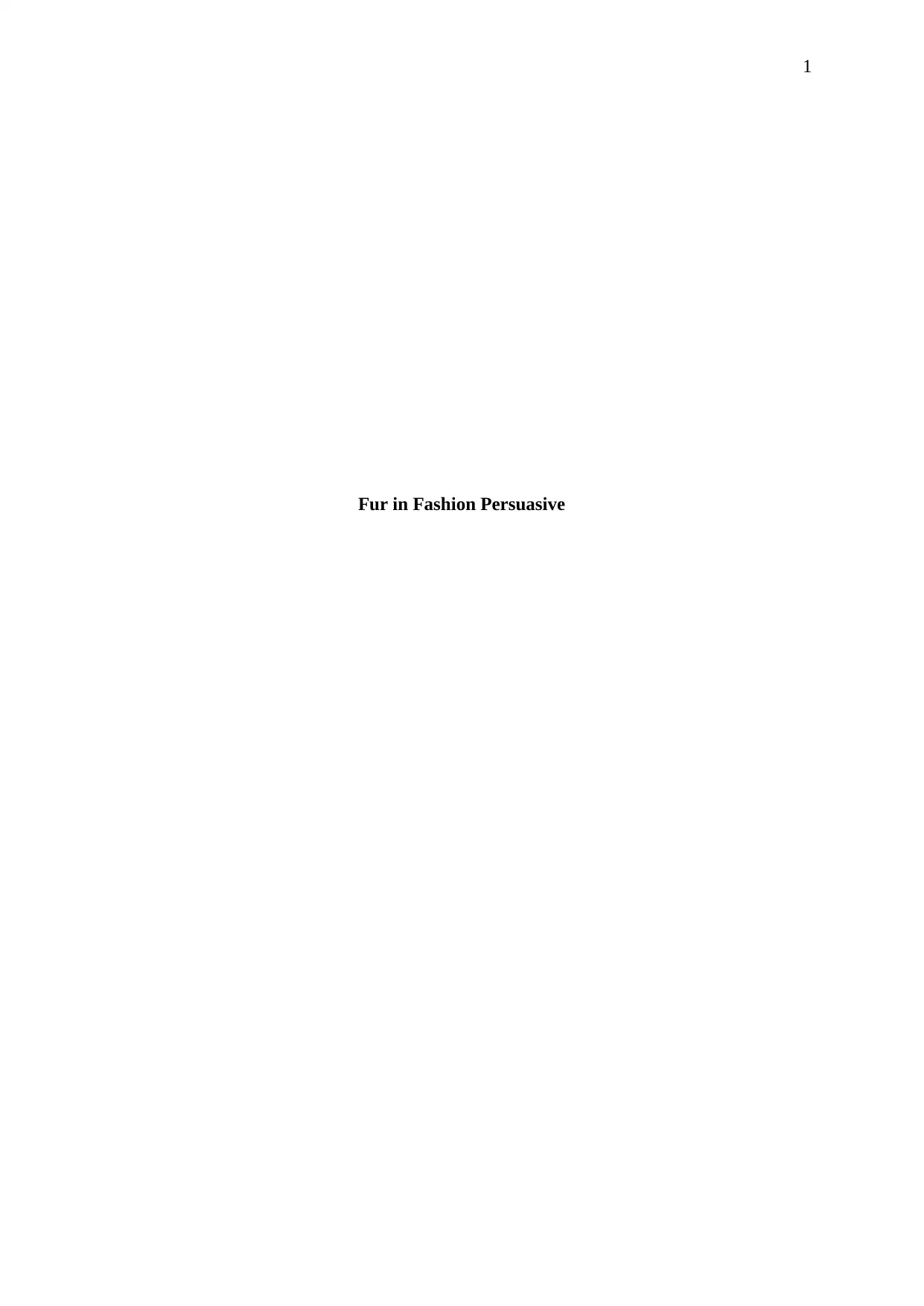
1
Fur in Fashion Persuasive
Fur in Fashion Persuasive
Secure Best Marks with AI Grader
Need help grading? Try our AI Grader for instant feedback on your assignments.
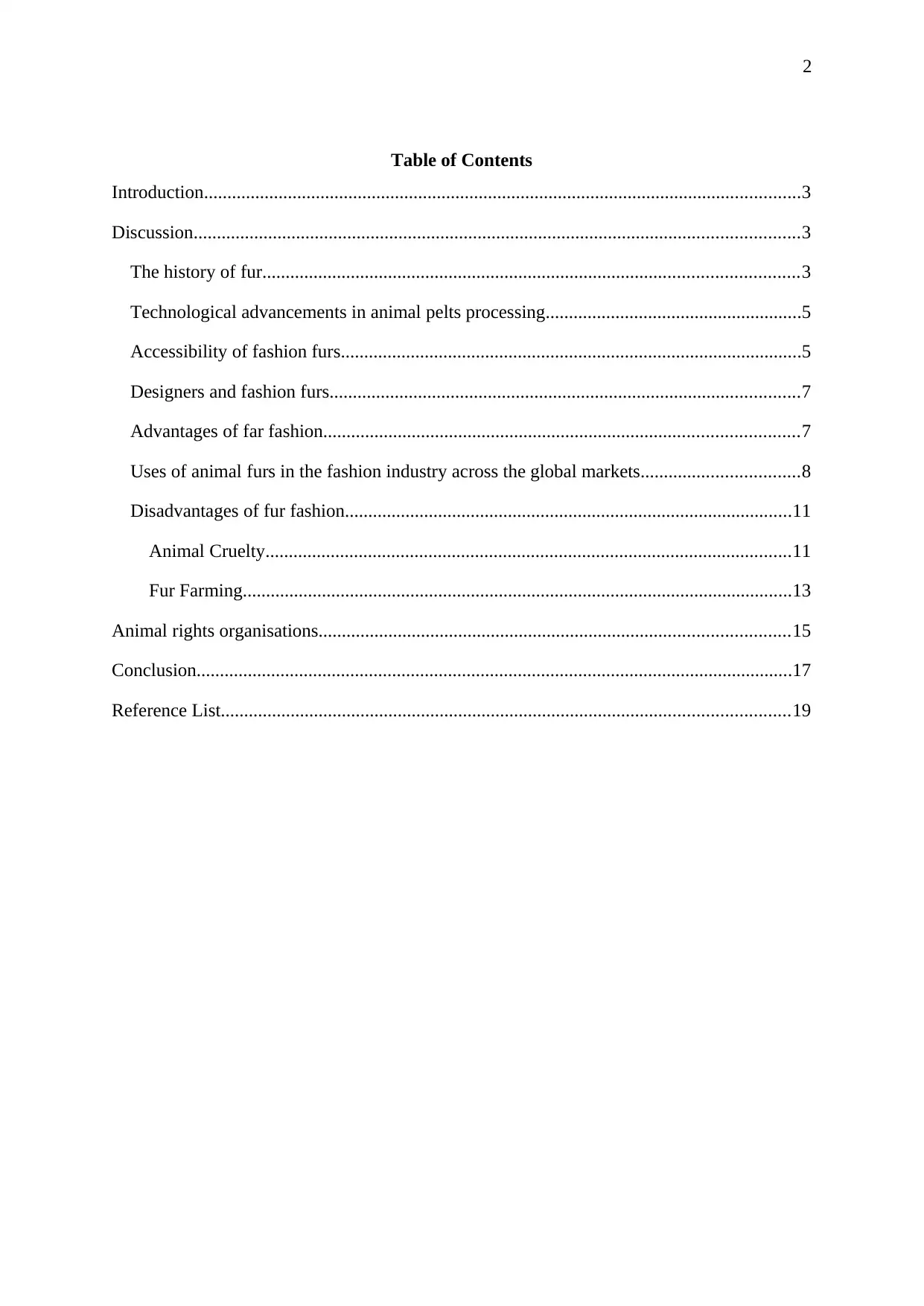
2
Table of Contents
Introduction................................................................................................................................3
Discussion..................................................................................................................................3
The history of fur...................................................................................................................3
Technological advancements in animal pelts processing.......................................................5
Accessibility of fashion furs...................................................................................................5
Designers and fashion furs.....................................................................................................7
Advantages of far fashion......................................................................................................7
Uses of animal furs in the fashion industry across the global markets..................................8
Disadvantages of fur fashion................................................................................................11
Animal Cruelty.................................................................................................................11
Fur Farming......................................................................................................................13
Animal rights organisations.....................................................................................................15
Conclusion................................................................................................................................17
Reference List..........................................................................................................................19
Table of Contents
Introduction................................................................................................................................3
Discussion..................................................................................................................................3
The history of fur...................................................................................................................3
Technological advancements in animal pelts processing.......................................................5
Accessibility of fashion furs...................................................................................................5
Designers and fashion furs.....................................................................................................7
Advantages of far fashion......................................................................................................7
Uses of animal furs in the fashion industry across the global markets..................................8
Disadvantages of fur fashion................................................................................................11
Animal Cruelty.................................................................................................................11
Fur Farming......................................................................................................................13
Animal rights organisations.....................................................................................................15
Conclusion................................................................................................................................17
Reference List..........................................................................................................................19
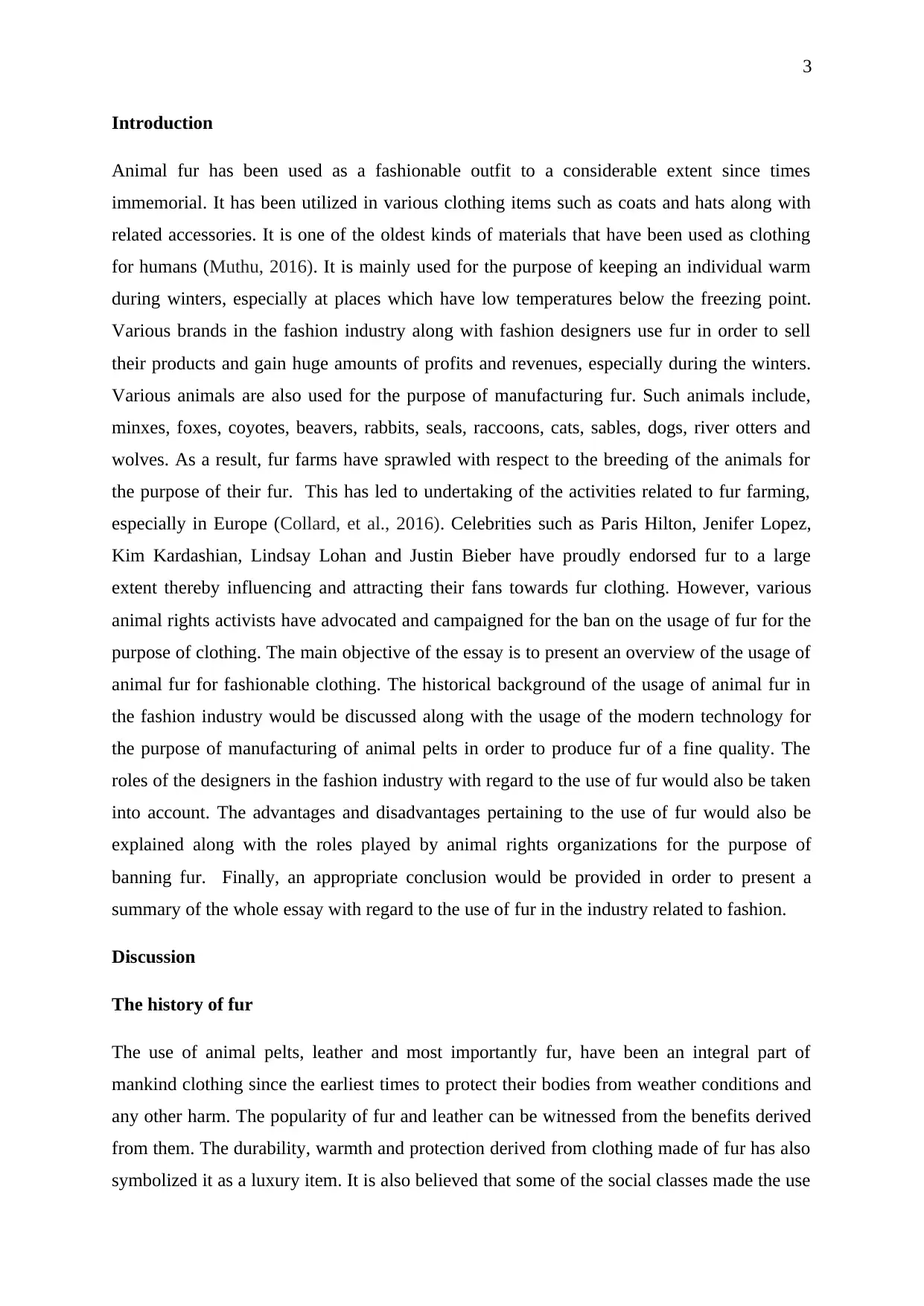
3
Introduction
Animal fur has been used as a fashionable outfit to a considerable extent since times
immemorial. It has been utilized in various clothing items such as coats and hats along with
related accessories. It is one of the oldest kinds of materials that have been used as clothing
for humans (Muthu, 2016). It is mainly used for the purpose of keeping an individual warm
during winters, especially at places which have low temperatures below the freezing point.
Various brands in the fashion industry along with fashion designers use fur in order to sell
their products and gain huge amounts of profits and revenues, especially during the winters.
Various animals are also used for the purpose of manufacturing fur. Such animals include,
minxes, foxes, coyotes, beavers, rabbits, seals, raccoons, cats, sables, dogs, river otters and
wolves. As a result, fur farms have sprawled with respect to the breeding of the animals for
the purpose of their fur. This has led to undertaking of the activities related to fur farming,
especially in Europe (Collard, et al., 2016). Celebrities such as Paris Hilton, Jenifer Lopez,
Kim Kardashian, Lindsay Lohan and Justin Bieber have proudly endorsed fur to a large
extent thereby influencing and attracting their fans towards fur clothing. However, various
animal rights activists have advocated and campaigned for the ban on the usage of fur for the
purpose of clothing. The main objective of the essay is to present an overview of the usage of
animal fur for fashionable clothing. The historical background of the usage of animal fur in
the fashion industry would be discussed along with the usage of the modern technology for
the purpose of manufacturing of animal pelts in order to produce fur of a fine quality. The
roles of the designers in the fashion industry with regard to the use of fur would also be taken
into account. The advantages and disadvantages pertaining to the use of fur would also be
explained along with the roles played by animal rights organizations for the purpose of
banning fur. Finally, an appropriate conclusion would be provided in order to present a
summary of the whole essay with regard to the use of fur in the industry related to fashion.
Discussion
The history of fur
The use of animal pelts, leather and most importantly fur, have been an integral part of
mankind clothing since the earliest times to protect their bodies from weather conditions and
any other harm. The popularity of fur and leather can be witnessed from the benefits derived
from them. The durability, warmth and protection derived from clothing made of fur has also
symbolized it as a luxury item. It is also believed that some of the social classes made the use
Introduction
Animal fur has been used as a fashionable outfit to a considerable extent since times
immemorial. It has been utilized in various clothing items such as coats and hats along with
related accessories. It is one of the oldest kinds of materials that have been used as clothing
for humans (Muthu, 2016). It is mainly used for the purpose of keeping an individual warm
during winters, especially at places which have low temperatures below the freezing point.
Various brands in the fashion industry along with fashion designers use fur in order to sell
their products and gain huge amounts of profits and revenues, especially during the winters.
Various animals are also used for the purpose of manufacturing fur. Such animals include,
minxes, foxes, coyotes, beavers, rabbits, seals, raccoons, cats, sables, dogs, river otters and
wolves. As a result, fur farms have sprawled with respect to the breeding of the animals for
the purpose of their fur. This has led to undertaking of the activities related to fur farming,
especially in Europe (Collard, et al., 2016). Celebrities such as Paris Hilton, Jenifer Lopez,
Kim Kardashian, Lindsay Lohan and Justin Bieber have proudly endorsed fur to a large
extent thereby influencing and attracting their fans towards fur clothing. However, various
animal rights activists have advocated and campaigned for the ban on the usage of fur for the
purpose of clothing. The main objective of the essay is to present an overview of the usage of
animal fur for fashionable clothing. The historical background of the usage of animal fur in
the fashion industry would be discussed along with the usage of the modern technology for
the purpose of manufacturing of animal pelts in order to produce fur of a fine quality. The
roles of the designers in the fashion industry with regard to the use of fur would also be taken
into account. The advantages and disadvantages pertaining to the use of fur would also be
explained along with the roles played by animal rights organizations for the purpose of
banning fur. Finally, an appropriate conclusion would be provided in order to present a
summary of the whole essay with regard to the use of fur in the industry related to fashion.
Discussion
The history of fur
The use of animal pelts, leather and most importantly fur, have been an integral part of
mankind clothing since the earliest times to protect their bodies from weather conditions and
any other harm. The popularity of fur and leather can be witnessed from the benefits derived
from them. The durability, warmth and protection derived from clothing made of fur has also
symbolized it as a luxury item. It is also believed that some of the social classes made the use
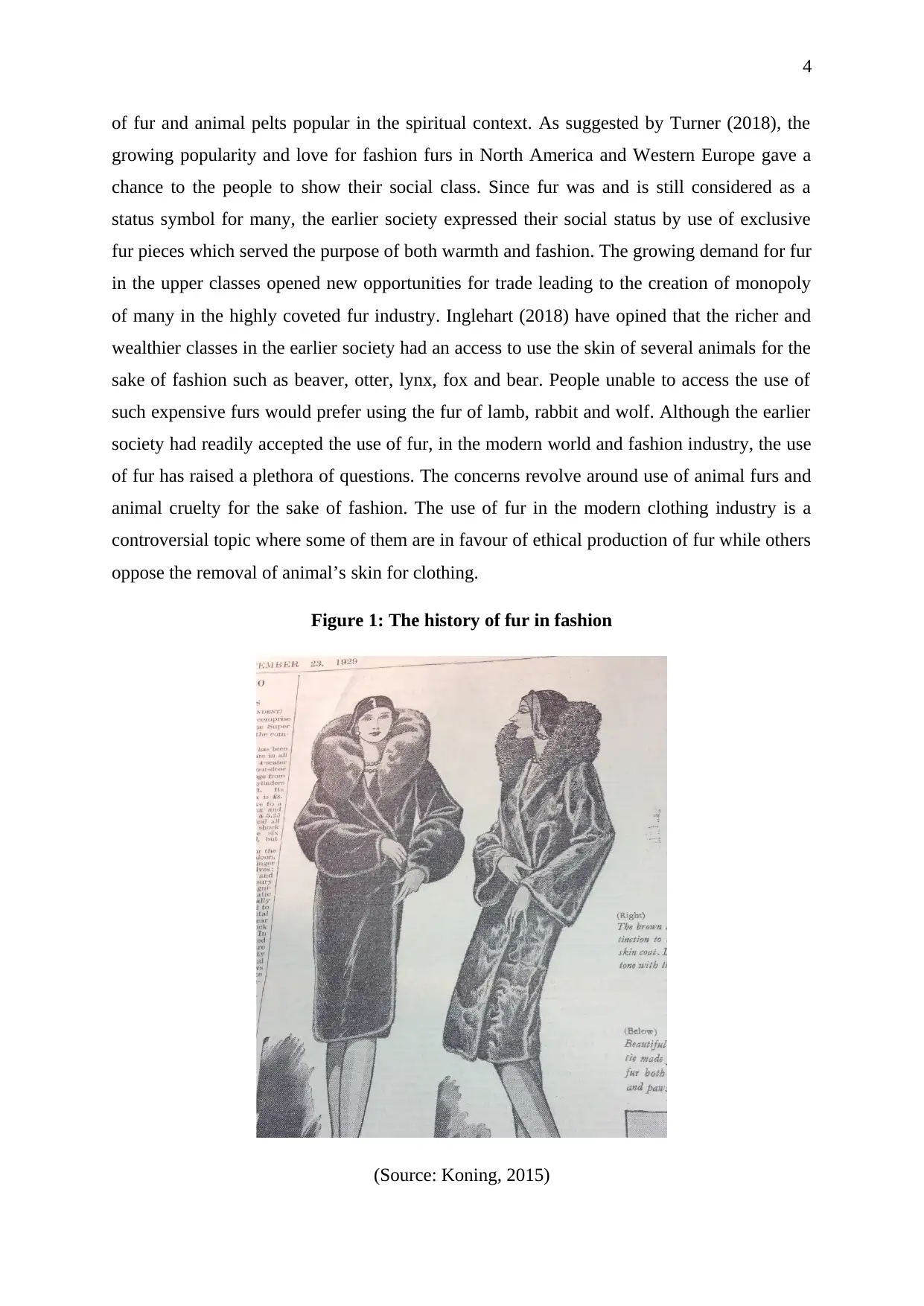
4
of fur and animal pelts popular in the spiritual context. As suggested by Turner (2018), the
growing popularity and love for fashion furs in North America and Western Europe gave a
chance to the people to show their social class. Since fur was and is still considered as a
status symbol for many, the earlier society expressed their social status by use of exclusive
fur pieces which served the purpose of both warmth and fashion. The growing demand for fur
in the upper classes opened new opportunities for trade leading to the creation of monopoly
of many in the highly coveted fur industry. Inglehart (2018) have opined that the richer and
wealthier classes in the earlier society had an access to use the skin of several animals for the
sake of fashion such as beaver, otter, lynx, fox and bear. People unable to access the use of
such expensive furs would prefer using the fur of lamb, rabbit and wolf. Although the earlier
society had readily accepted the use of fur, in the modern world and fashion industry, the use
of fur has raised a plethora of questions. The concerns revolve around use of animal furs and
animal cruelty for the sake of fashion. The use of fur in the modern clothing industry is a
controversial topic where some of them are in favour of ethical production of fur while others
oppose the removal of animal’s skin for clothing.
Figure 1: The history of fur in fashion
(Source: Koning, 2015)
of fur and animal pelts popular in the spiritual context. As suggested by Turner (2018), the
growing popularity and love for fashion furs in North America and Western Europe gave a
chance to the people to show their social class. Since fur was and is still considered as a
status symbol for many, the earlier society expressed their social status by use of exclusive
fur pieces which served the purpose of both warmth and fashion. The growing demand for fur
in the upper classes opened new opportunities for trade leading to the creation of monopoly
of many in the highly coveted fur industry. Inglehart (2018) have opined that the richer and
wealthier classes in the earlier society had an access to use the skin of several animals for the
sake of fashion such as beaver, otter, lynx, fox and bear. People unable to access the use of
such expensive furs would prefer using the fur of lamb, rabbit and wolf. Although the earlier
society had readily accepted the use of fur, in the modern world and fashion industry, the use
of fur has raised a plethora of questions. The concerns revolve around use of animal furs and
animal cruelty for the sake of fashion. The use of fur in the modern clothing industry is a
controversial topic where some of them are in favour of ethical production of fur while others
oppose the removal of animal’s skin for clothing.
Figure 1: The history of fur in fashion
(Source: Koning, 2015)
Secure Best Marks with AI Grader
Need help grading? Try our AI Grader for instant feedback on your assignments.
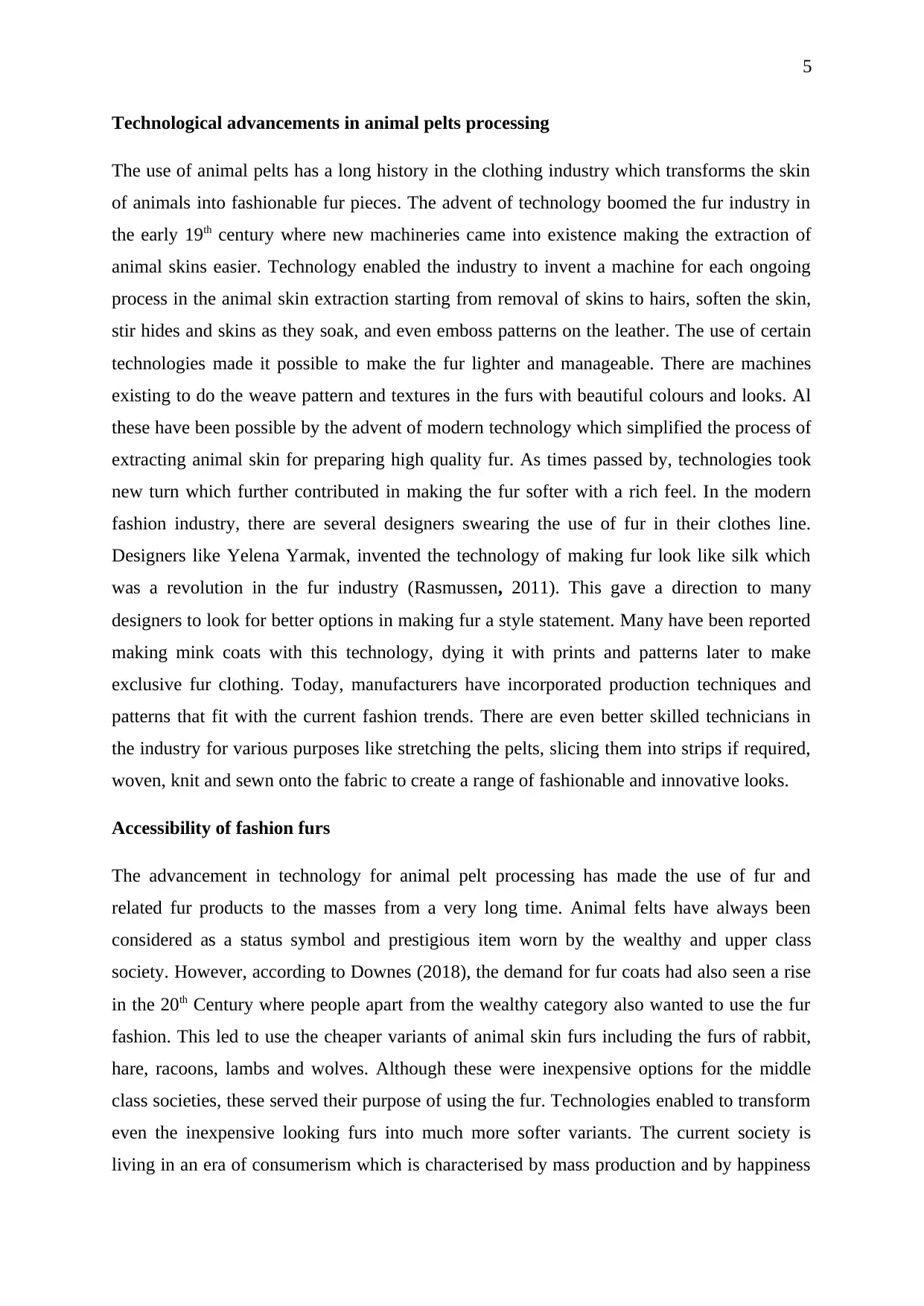
5
Technological advancements in animal pelts processing
The use of animal pelts has a long history in the clothing industry which transforms the skin
of animals into fashionable fur pieces. The advent of technology boomed the fur industry in
the early 19th century where new machineries came into existence making the extraction of
animal skins easier. Technology enabled the industry to invent a machine for each ongoing
process in the animal skin extraction starting from removal of skins to hairs, soften the skin,
stir hides and skins as they soak, and even emboss patterns on the leather. The use of certain
technologies made it possible to make the fur lighter and manageable. There are machines
existing to do the weave pattern and textures in the furs with beautiful colours and looks. Al
these have been possible by the advent of modern technology which simplified the process of
extracting animal skin for preparing high quality fur. As times passed by, technologies took
new turn which further contributed in making the fur softer with a rich feel. In the modern
fashion industry, there are several designers swearing the use of fur in their clothes line.
Designers like Yelena Yarmak, invented the technology of making fur look like silk which
was a revolution in the fur industry (Rasmussen, 2011). This gave a direction to many
designers to look for better options in making fur a style statement. Many have been reported
making mink coats with this technology, dying it with prints and patterns later to make
exclusive fur clothing. Today, manufacturers have incorporated production techniques and
patterns that fit with the current fashion trends. There are even better skilled technicians in
the industry for various purposes like stretching the pelts, slicing them into strips if required,
woven, knit and sewn onto the fabric to create a range of fashionable and innovative looks.
Accessibility of fashion furs
The advancement in technology for animal pelt processing has made the use of fur and
related fur products to the masses from a very long time. Animal felts have always been
considered as a status symbol and prestigious item worn by the wealthy and upper class
society. However, according to Downes (2018), the demand for fur coats had also seen a rise
in the 20th Century where people apart from the wealthy category also wanted to use the fur
fashion. This led to use the cheaper variants of animal skin furs including the furs of rabbit,
hare, racoons, lambs and wolves. Although these were inexpensive options for the middle
class societies, these served their purpose of using the fur. Technologies enabled to transform
even the inexpensive looking furs into much more softer variants. The current society is
living in an era of consumerism which is characterised by mass production and by happiness
Technological advancements in animal pelts processing
The use of animal pelts has a long history in the clothing industry which transforms the skin
of animals into fashionable fur pieces. The advent of technology boomed the fur industry in
the early 19th century where new machineries came into existence making the extraction of
animal skins easier. Technology enabled the industry to invent a machine for each ongoing
process in the animal skin extraction starting from removal of skins to hairs, soften the skin,
stir hides and skins as they soak, and even emboss patterns on the leather. The use of certain
technologies made it possible to make the fur lighter and manageable. There are machines
existing to do the weave pattern and textures in the furs with beautiful colours and looks. Al
these have been possible by the advent of modern technology which simplified the process of
extracting animal skin for preparing high quality fur. As times passed by, technologies took
new turn which further contributed in making the fur softer with a rich feel. In the modern
fashion industry, there are several designers swearing the use of fur in their clothes line.
Designers like Yelena Yarmak, invented the technology of making fur look like silk which
was a revolution in the fur industry (Rasmussen, 2011). This gave a direction to many
designers to look for better options in making fur a style statement. Many have been reported
making mink coats with this technology, dying it with prints and patterns later to make
exclusive fur clothing. Today, manufacturers have incorporated production techniques and
patterns that fit with the current fashion trends. There are even better skilled technicians in
the industry for various purposes like stretching the pelts, slicing them into strips if required,
woven, knit and sewn onto the fabric to create a range of fashionable and innovative looks.
Accessibility of fashion furs
The advancement in technology for animal pelt processing has made the use of fur and
related fur products to the masses from a very long time. Animal felts have always been
considered as a status symbol and prestigious item worn by the wealthy and upper class
society. However, according to Downes (2018), the demand for fur coats had also seen a rise
in the 20th Century where people apart from the wealthy category also wanted to use the fur
fashion. This led to use the cheaper variants of animal skin furs including the furs of rabbit,
hare, racoons, lambs and wolves. Although these were inexpensive options for the middle
class societies, these served their purpose of using the fur. Technologies enabled to transform
even the inexpensive looking furs into much more softer variants. The current society is
living in an era of consumerism which is characterised by mass production and by happiness
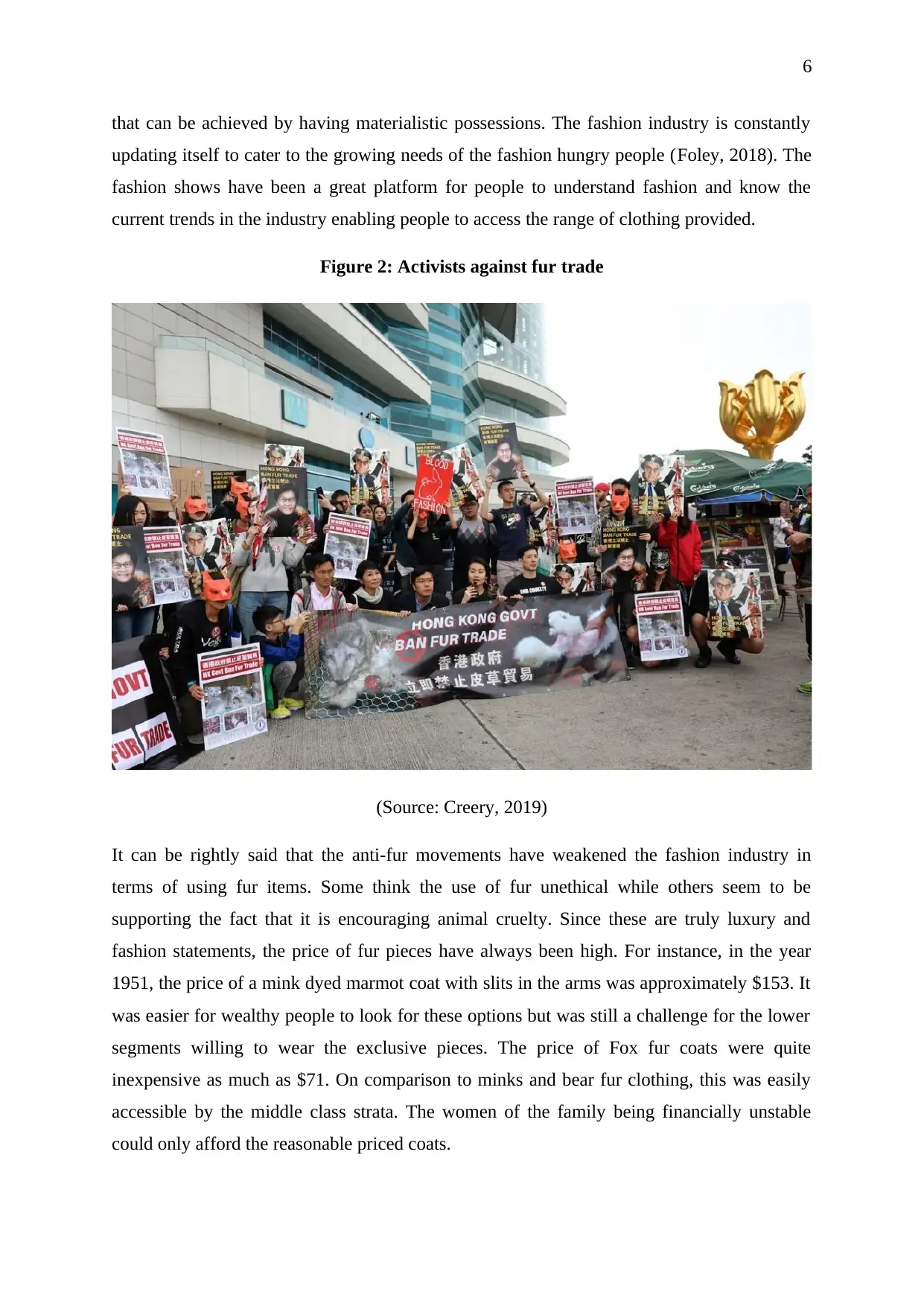
6
that can be achieved by having materialistic possessions. The fashion industry is constantly
updating itself to cater to the growing needs of the fashion hungry people (Foley, 2018). The
fashion shows have been a great platform for people to understand fashion and know the
current trends in the industry enabling people to access the range of clothing provided.
Figure 2: Activists against fur trade
(Source: Creery, 2019)
It can be rightly said that the anti-fur movements have weakened the fashion industry in
terms of using fur items. Some think the use of fur unethical while others seem to be
supporting the fact that it is encouraging animal cruelty. Since these are truly luxury and
fashion statements, the price of fur pieces have always been high. For instance, in the year
1951, the price of a mink dyed marmot coat with slits in the arms was approximately $153. It
was easier for wealthy people to look for these options but was still a challenge for the lower
segments willing to wear the exclusive pieces. The price of Fox fur coats were quite
inexpensive as much as $71. On comparison to minks and bear fur clothing, this was easily
accessible by the middle class strata. The women of the family being financially unstable
could only afford the reasonable priced coats.
that can be achieved by having materialistic possessions. The fashion industry is constantly
updating itself to cater to the growing needs of the fashion hungry people (Foley, 2018). The
fashion shows have been a great platform for people to understand fashion and know the
current trends in the industry enabling people to access the range of clothing provided.
Figure 2: Activists against fur trade
(Source: Creery, 2019)
It can be rightly said that the anti-fur movements have weakened the fashion industry in
terms of using fur items. Some think the use of fur unethical while others seem to be
supporting the fact that it is encouraging animal cruelty. Since these are truly luxury and
fashion statements, the price of fur pieces have always been high. For instance, in the year
1951, the price of a mink dyed marmot coat with slits in the arms was approximately $153. It
was easier for wealthy people to look for these options but was still a challenge for the lower
segments willing to wear the exclusive pieces. The price of Fox fur coats were quite
inexpensive as much as $71. On comparison to minks and bear fur clothing, this was easily
accessible by the middle class strata. The women of the family being financially unstable
could only afford the reasonable priced coats.
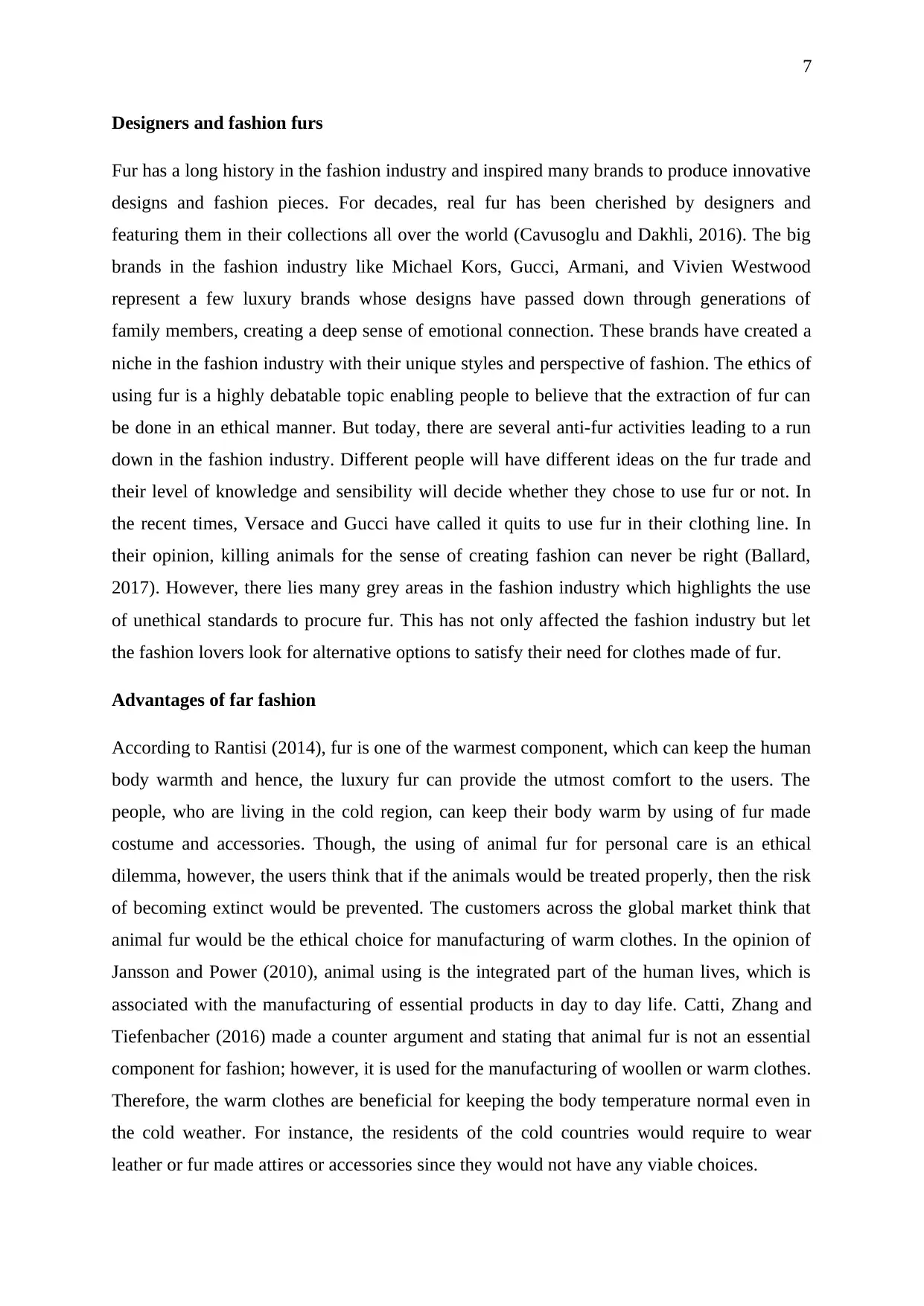
7
Designers and fashion furs
Fur has a long history in the fashion industry and inspired many brands to produce innovative
designs and fashion pieces. For decades, real fur has been cherished by designers and
featuring them in their collections all over the world (Cavusoglu and Dakhli, 2016). The big
brands in the fashion industry like Michael Kors, Gucci, Armani, and Vivien Westwood
represent a few luxury brands whose designs have passed down through generations of
family members, creating a deep sense of emotional connection. These brands have created a
niche in the fashion industry with their unique styles and perspective of fashion. The ethics of
using fur is a highly debatable topic enabling people to believe that the extraction of fur can
be done in an ethical manner. But today, there are several anti-fur activities leading to a run
down in the fashion industry. Different people will have different ideas on the fur trade and
their level of knowledge and sensibility will decide whether they chose to use fur or not. In
the recent times, Versace and Gucci have called it quits to use fur in their clothing line. In
their opinion, killing animals for the sense of creating fashion can never be right (Ballard,
2017). However, there lies many grey areas in the fashion industry which highlights the use
of unethical standards to procure fur. This has not only affected the fashion industry but let
the fashion lovers look for alternative options to satisfy their need for clothes made of fur.
Advantages of far fashion
According to Rantisi (2014), fur is one of the warmest component, which can keep the human
body warmth and hence, the luxury fur can provide the utmost comfort to the users. The
people, who are living in the cold region, can keep their body warm by using of fur made
costume and accessories. Though, the using of animal fur for personal care is an ethical
dilemma, however, the users think that if the animals would be treated properly, then the risk
of becoming extinct would be prevented. The customers across the global market think that
animal fur would be the ethical choice for manufacturing of warm clothes. In the opinion of
Jansson and Power (2010), animal using is the integrated part of the human lives, which is
associated with the manufacturing of essential products in day to day life. Catti, Zhang and
Tiefenbacher (2016) made a counter argument and stating that animal fur is not an essential
component for fashion; however, it is used for the manufacturing of woollen or warm clothes.
Therefore, the warm clothes are beneficial for keeping the body temperature normal even in
the cold weather. For instance, the residents of the cold countries would require to wear
leather or fur made attires or accessories since they would not have any viable choices.
Designers and fashion furs
Fur has a long history in the fashion industry and inspired many brands to produce innovative
designs and fashion pieces. For decades, real fur has been cherished by designers and
featuring them in their collections all over the world (Cavusoglu and Dakhli, 2016). The big
brands in the fashion industry like Michael Kors, Gucci, Armani, and Vivien Westwood
represent a few luxury brands whose designs have passed down through generations of
family members, creating a deep sense of emotional connection. These brands have created a
niche in the fashion industry with their unique styles and perspective of fashion. The ethics of
using fur is a highly debatable topic enabling people to believe that the extraction of fur can
be done in an ethical manner. But today, there are several anti-fur activities leading to a run
down in the fashion industry. Different people will have different ideas on the fur trade and
their level of knowledge and sensibility will decide whether they chose to use fur or not. In
the recent times, Versace and Gucci have called it quits to use fur in their clothing line. In
their opinion, killing animals for the sense of creating fashion can never be right (Ballard,
2017). However, there lies many grey areas in the fashion industry which highlights the use
of unethical standards to procure fur. This has not only affected the fashion industry but let
the fashion lovers look for alternative options to satisfy their need for clothes made of fur.
Advantages of far fashion
According to Rantisi (2014), fur is one of the warmest component, which can keep the human
body warmth and hence, the luxury fur can provide the utmost comfort to the users. The
people, who are living in the cold region, can keep their body warm by using of fur made
costume and accessories. Though, the using of animal fur for personal care is an ethical
dilemma, however, the users think that if the animals would be treated properly, then the risk
of becoming extinct would be prevented. The customers across the global market think that
animal fur would be the ethical choice for manufacturing of warm clothes. In the opinion of
Jansson and Power (2010), animal using is the integrated part of the human lives, which is
associated with the manufacturing of essential products in day to day life. Catti, Zhang and
Tiefenbacher (2016) made a counter argument and stating that animal fur is not an essential
component for fashion; however, it is used for the manufacturing of woollen or warm clothes.
Therefore, the warm clothes are beneficial for keeping the body temperature normal even in
the cold weather. For instance, the residents of the cold countries would require to wear
leather or fur made attires or accessories since they would not have any viable choices.
Paraphrase This Document
Need a fresh take? Get an instant paraphrase of this document with our AI Paraphraser
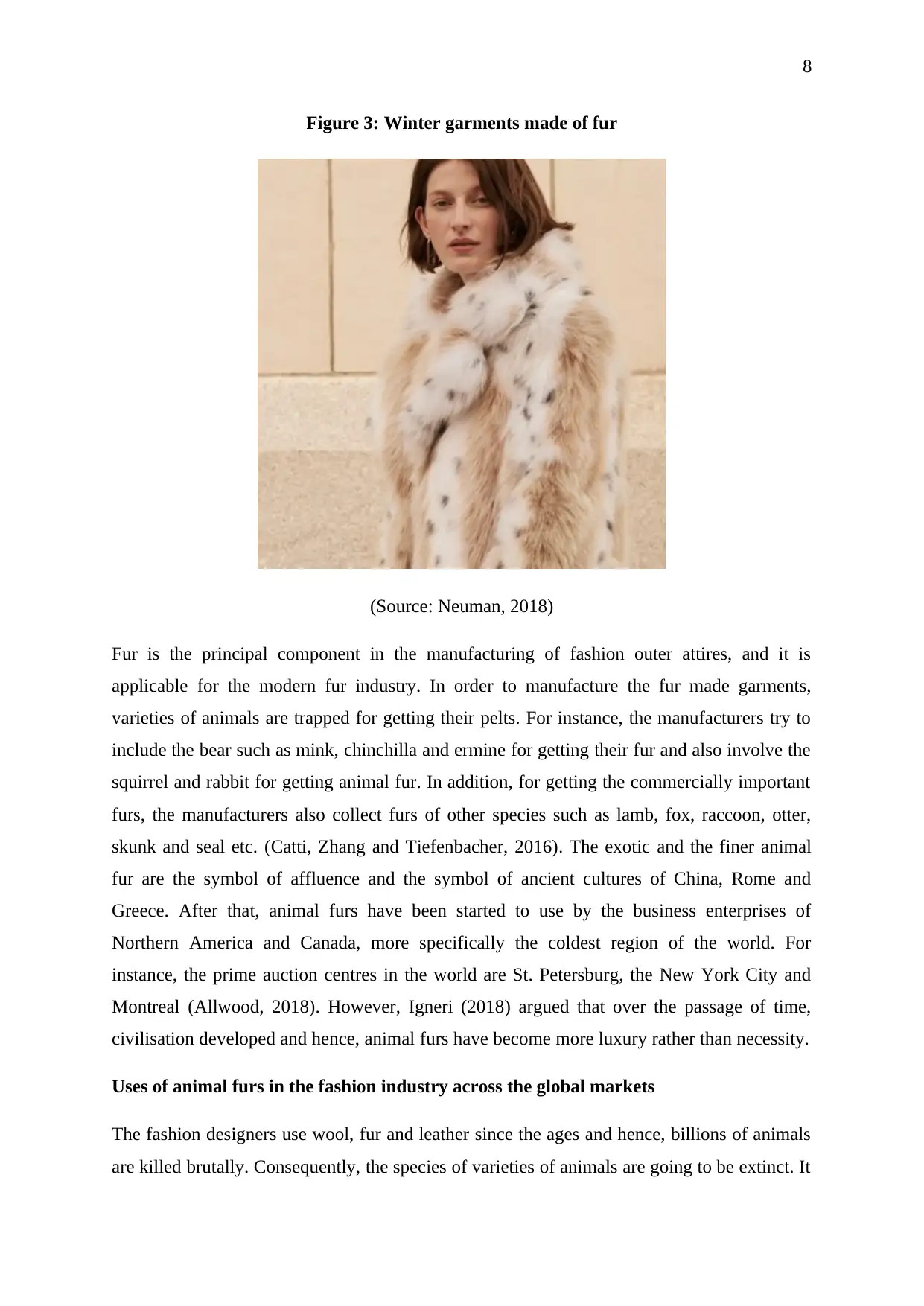
8
Figure 3: Winter garments made of fur
(Source: Neuman, 2018)
Fur is the principal component in the manufacturing of fashion outer attires, and it is
applicable for the modern fur industry. In order to manufacture the fur made garments,
varieties of animals are trapped for getting their pelts. For instance, the manufacturers try to
include the bear such as mink, chinchilla and ermine for getting their fur and also involve the
squirrel and rabbit for getting animal fur. In addition, for getting the commercially important
furs, the manufacturers also collect furs of other species such as lamb, fox, raccoon, otter,
skunk and seal etc. (Catti, Zhang and Tiefenbacher, 2016). The exotic and the finer animal
fur are the symbol of affluence and the symbol of ancient cultures of China, Rome and
Greece. After that, animal furs have been started to use by the business enterprises of
Northern America and Canada, more specifically the coldest region of the world. For
instance, the prime auction centres in the world are St. Petersburg, the New York City and
Montreal (Allwood, 2018). However, Igneri (2018) argued that over the passage of time,
civilisation developed and hence, animal furs have become more luxury rather than necessity.
Uses of animal furs in the fashion industry across the global markets
The fashion designers use wool, fur and leather since the ages and hence, billions of animals
are killed brutally. Consequently, the species of varieties of animals are going to be extinct. It
Figure 3: Winter garments made of fur
(Source: Neuman, 2018)
Fur is the principal component in the manufacturing of fashion outer attires, and it is
applicable for the modern fur industry. In order to manufacture the fur made garments,
varieties of animals are trapped for getting their pelts. For instance, the manufacturers try to
include the bear such as mink, chinchilla and ermine for getting their fur and also involve the
squirrel and rabbit for getting animal fur. In addition, for getting the commercially important
furs, the manufacturers also collect furs of other species such as lamb, fox, raccoon, otter,
skunk and seal etc. (Catti, Zhang and Tiefenbacher, 2016). The exotic and the finer animal
fur are the symbol of affluence and the symbol of ancient cultures of China, Rome and
Greece. After that, animal furs have been started to use by the business enterprises of
Northern America and Canada, more specifically the coldest region of the world. For
instance, the prime auction centres in the world are St. Petersburg, the New York City and
Montreal (Allwood, 2018). However, Igneri (2018) argued that over the passage of time,
civilisation developed and hence, animal furs have become more luxury rather than necessity.
Uses of animal furs in the fashion industry across the global markets
The fashion designers use wool, fur and leather since the ages and hence, billions of animals
are killed brutally. Consequently, the species of varieties of animals are going to be extinct. It
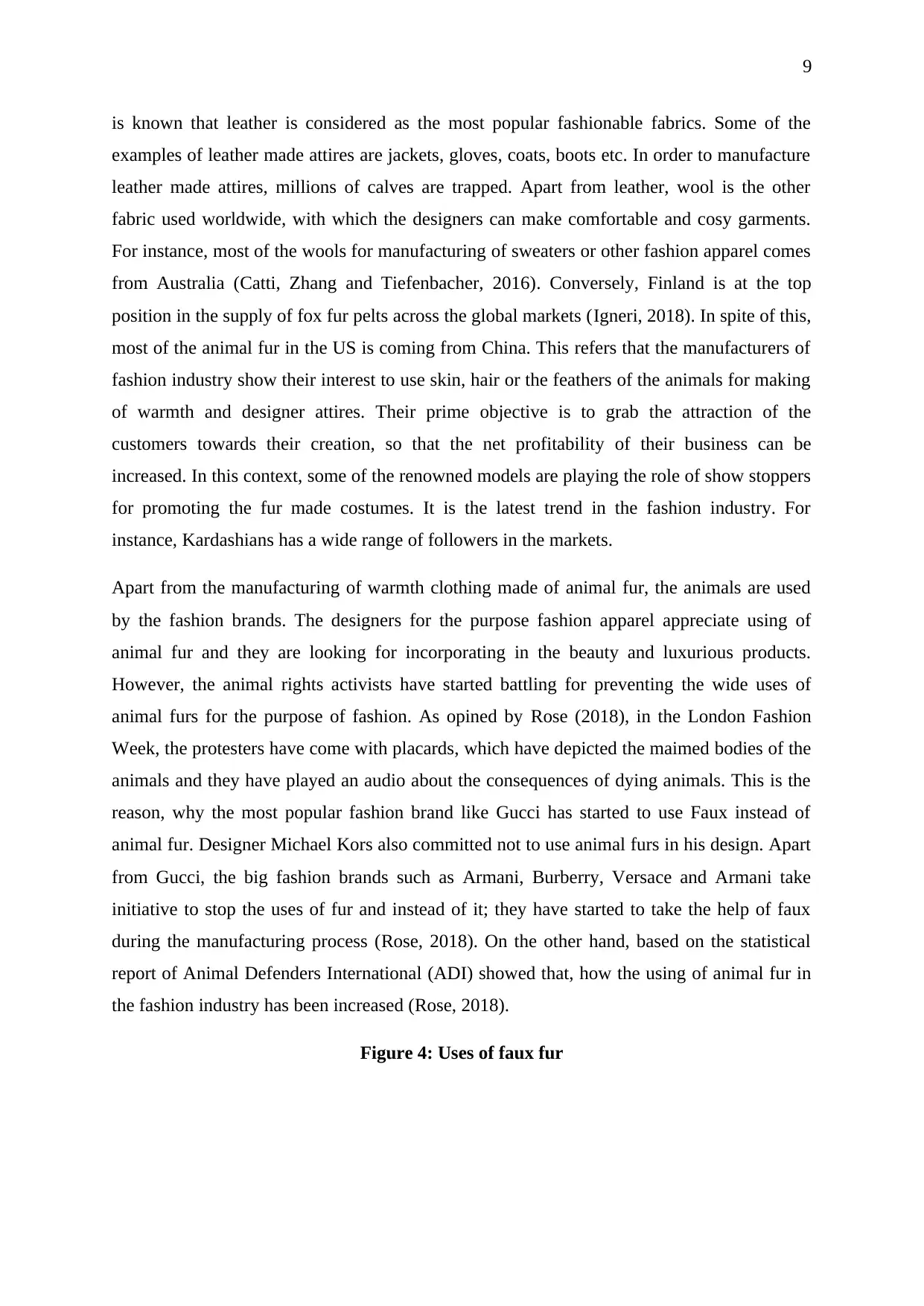
9
is known that leather is considered as the most popular fashionable fabrics. Some of the
examples of leather made attires are jackets, gloves, coats, boots etc. In order to manufacture
leather made attires, millions of calves are trapped. Apart from leather, wool is the other
fabric used worldwide, with which the designers can make comfortable and cosy garments.
For instance, most of the wools for manufacturing of sweaters or other fashion apparel comes
from Australia (Catti, Zhang and Tiefenbacher, 2016). Conversely, Finland is at the top
position in the supply of fox fur pelts across the global markets (Igneri, 2018). In spite of this,
most of the animal fur in the US is coming from China. This refers that the manufacturers of
fashion industry show their interest to use skin, hair or the feathers of the animals for making
of warmth and designer attires. Their prime objective is to grab the attraction of the
customers towards their creation, so that the net profitability of their business can be
increased. In this context, some of the renowned models are playing the role of show stoppers
for promoting the fur made costumes. It is the latest trend in the fashion industry. For
instance, Kardashians has a wide range of followers in the markets.
Apart from the manufacturing of warmth clothing made of animal fur, the animals are used
by the fashion brands. The designers for the purpose fashion apparel appreciate using of
animal fur and they are looking for incorporating in the beauty and luxurious products.
However, the animal rights activists have started battling for preventing the wide uses of
animal furs for the purpose of fashion. As opined by Rose (2018), in the London Fashion
Week, the protesters have come with placards, which have depicted the maimed bodies of the
animals and they have played an audio about the consequences of dying animals. This is the
reason, why the most popular fashion brand like Gucci has started to use Faux instead of
animal fur. Designer Michael Kors also committed not to use animal furs in his design. Apart
from Gucci, the big fashion brands such as Armani, Burberry, Versace and Armani take
initiative to stop the uses of fur and instead of it; they have started to take the help of faux
during the manufacturing process (Rose, 2018). On the other hand, based on the statistical
report of Animal Defenders International (ADI) showed that, how the using of animal fur in
the fashion industry has been increased (Rose, 2018).
Figure 4: Uses of faux fur
is known that leather is considered as the most popular fashionable fabrics. Some of the
examples of leather made attires are jackets, gloves, coats, boots etc. In order to manufacture
leather made attires, millions of calves are trapped. Apart from leather, wool is the other
fabric used worldwide, with which the designers can make comfortable and cosy garments.
For instance, most of the wools for manufacturing of sweaters or other fashion apparel comes
from Australia (Catti, Zhang and Tiefenbacher, 2016). Conversely, Finland is at the top
position in the supply of fox fur pelts across the global markets (Igneri, 2018). In spite of this,
most of the animal fur in the US is coming from China. This refers that the manufacturers of
fashion industry show their interest to use skin, hair or the feathers of the animals for making
of warmth and designer attires. Their prime objective is to grab the attraction of the
customers towards their creation, so that the net profitability of their business can be
increased. In this context, some of the renowned models are playing the role of show stoppers
for promoting the fur made costumes. It is the latest trend in the fashion industry. For
instance, Kardashians has a wide range of followers in the markets.
Apart from the manufacturing of warmth clothing made of animal fur, the animals are used
by the fashion brands. The designers for the purpose fashion apparel appreciate using of
animal fur and they are looking for incorporating in the beauty and luxurious products.
However, the animal rights activists have started battling for preventing the wide uses of
animal furs for the purpose of fashion. As opined by Rose (2018), in the London Fashion
Week, the protesters have come with placards, which have depicted the maimed bodies of the
animals and they have played an audio about the consequences of dying animals. This is the
reason, why the most popular fashion brand like Gucci has started to use Faux instead of
animal fur. Designer Michael Kors also committed not to use animal furs in his design. Apart
from Gucci, the big fashion brands such as Armani, Burberry, Versace and Armani take
initiative to stop the uses of fur and instead of it; they have started to take the help of faux
during the manufacturing process (Rose, 2018). On the other hand, based on the statistical
report of Animal Defenders International (ADI) showed that, how the using of animal fur in
the fashion industry has been increased (Rose, 2018).
Figure 4: Uses of faux fur
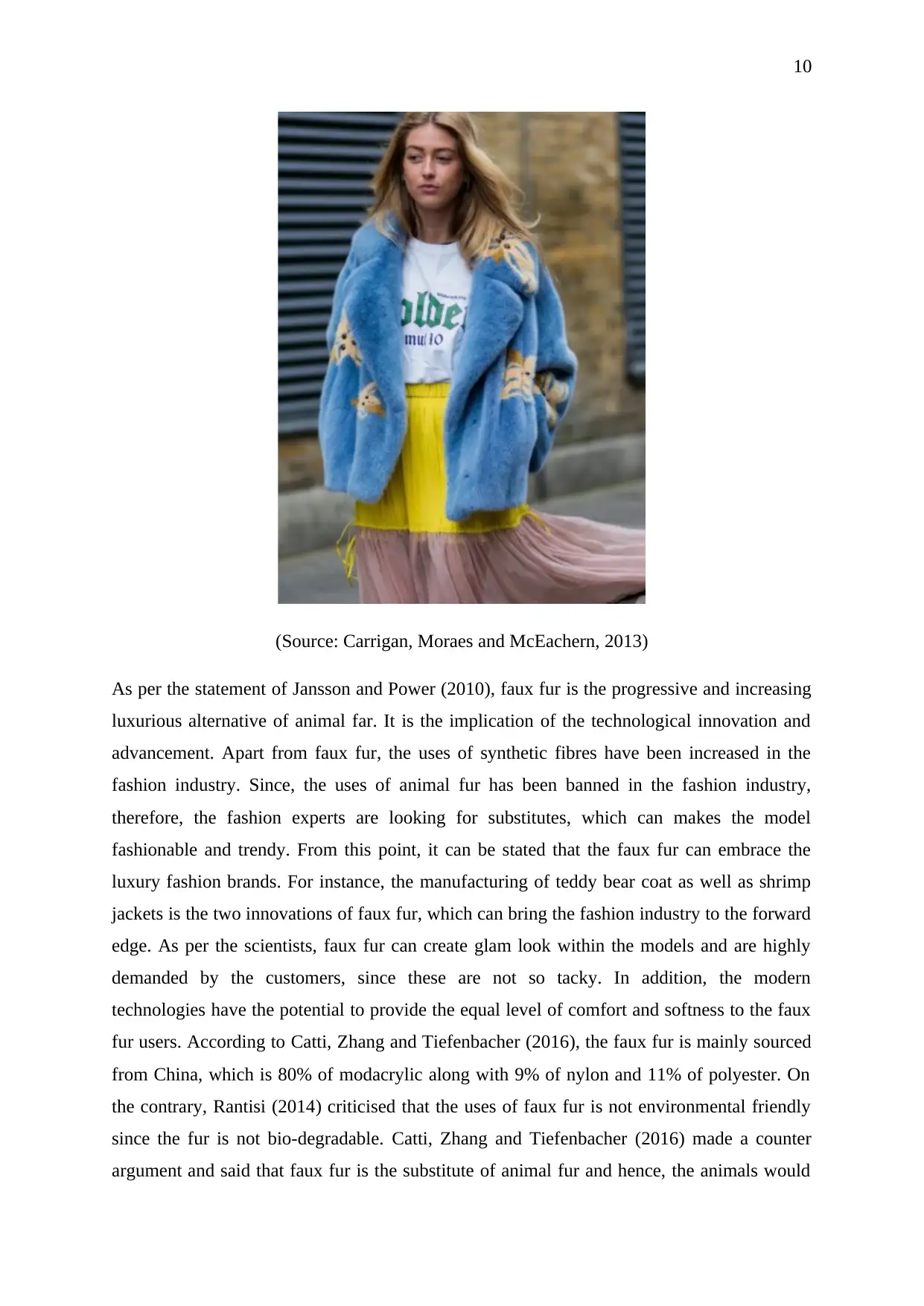
10
(Source: Carrigan, Moraes and McEachern, 2013)
As per the statement of Jansson and Power (2010), faux fur is the progressive and increasing
luxurious alternative of animal far. It is the implication of the technological innovation and
advancement. Apart from faux fur, the uses of synthetic fibres have been increased in the
fashion industry. Since, the uses of animal fur has been banned in the fashion industry,
therefore, the fashion experts are looking for substitutes, which can makes the model
fashionable and trendy. From this point, it can be stated that the faux fur can embrace the
luxury fashion brands. For instance, the manufacturing of teddy bear coat as well as shrimp
jackets is the two innovations of faux fur, which can bring the fashion industry to the forward
edge. As per the scientists, faux fur can create glam look within the models and are highly
demanded by the customers, since these are not so tacky. In addition, the modern
technologies have the potential to provide the equal level of comfort and softness to the faux
fur users. According to Catti, Zhang and Tiefenbacher (2016), the faux fur is mainly sourced
from China, which is 80% of modacrylic along with 9% of nylon and 11% of polyester. On
the contrary, Rantisi (2014) criticised that the uses of faux fur is not environmental friendly
since the fur is not bio-degradable. Catti, Zhang and Tiefenbacher (2016) made a counter
argument and said that faux fur is the substitute of animal fur and hence, the animals would
(Source: Carrigan, Moraes and McEachern, 2013)
As per the statement of Jansson and Power (2010), faux fur is the progressive and increasing
luxurious alternative of animal far. It is the implication of the technological innovation and
advancement. Apart from faux fur, the uses of synthetic fibres have been increased in the
fashion industry. Since, the uses of animal fur has been banned in the fashion industry,
therefore, the fashion experts are looking for substitutes, which can makes the model
fashionable and trendy. From this point, it can be stated that the faux fur can embrace the
luxury fashion brands. For instance, the manufacturing of teddy bear coat as well as shrimp
jackets is the two innovations of faux fur, which can bring the fashion industry to the forward
edge. As per the scientists, faux fur can create glam look within the models and are highly
demanded by the customers, since these are not so tacky. In addition, the modern
technologies have the potential to provide the equal level of comfort and softness to the faux
fur users. According to Catti, Zhang and Tiefenbacher (2016), the faux fur is mainly sourced
from China, which is 80% of modacrylic along with 9% of nylon and 11% of polyester. On
the contrary, Rantisi (2014) criticised that the uses of faux fur is not environmental friendly
since the fur is not bio-degradable. Catti, Zhang and Tiefenbacher (2016) made a counter
argument and said that faux fur is the substitute of animal fur and hence, the animals would
Secure Best Marks with AI Grader
Need help grading? Try our AI Grader for instant feedback on your assignments.
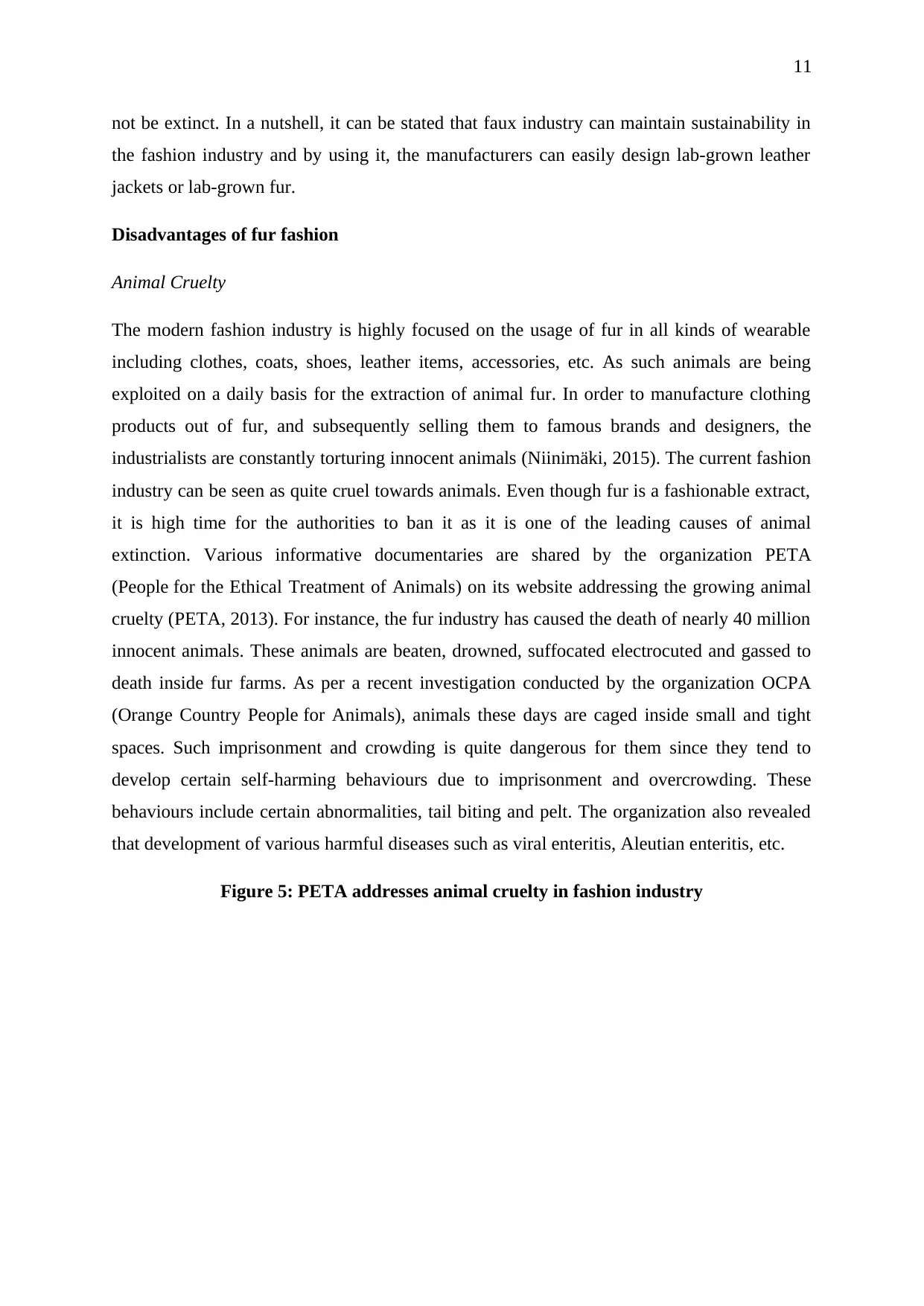
11
not be extinct. In a nutshell, it can be stated that faux industry can maintain sustainability in
the fashion industry and by using it, the manufacturers can easily design lab-grown leather
jackets or lab-grown fur.
Disadvantages of fur fashion
Animal Cruelty
The modern fashion industry is highly focused on the usage of fur in all kinds of wearable
including clothes, coats, shoes, leather items, accessories, etc. As such animals are being
exploited on a daily basis for the extraction of animal fur. In order to manufacture clothing
products out of fur, and subsequently selling them to famous brands and designers, the
industrialists are constantly torturing innocent animals (Niinimäki, 2015). The current fashion
industry can be seen as quite cruel towards animals. Even though fur is a fashionable extract,
it is high time for the authorities to ban it as it is one of the leading causes of animal
extinction. Various informative documentaries are shared by the organization PETA
(People for the Ethical Treatment of Animals) on its website addressing the growing animal
cruelty (PETA, 2013). For instance, the fur industry has caused the death of nearly 40 million
innocent animals. These animals are beaten, drowned, suffocated electrocuted and gassed to
death inside fur farms. As per a recent investigation conducted by the organization OCPA
(Orange Country People for Animals), animals these days are caged inside small and tight
spaces. Such imprisonment and crowding is quite dangerous for them since they tend to
develop certain self-harming behaviours due to imprisonment and overcrowding. These
behaviours include certain abnormalities, tail biting and pelt. The organization also revealed
that development of various harmful diseases such as viral enteritis, Aleutian enteritis, etc.
Figure 5: PETA addresses animal cruelty in fashion industry
not be extinct. In a nutshell, it can be stated that faux industry can maintain sustainability in
the fashion industry and by using it, the manufacturers can easily design lab-grown leather
jackets or lab-grown fur.
Disadvantages of fur fashion
Animal Cruelty
The modern fashion industry is highly focused on the usage of fur in all kinds of wearable
including clothes, coats, shoes, leather items, accessories, etc. As such animals are being
exploited on a daily basis for the extraction of animal fur. In order to manufacture clothing
products out of fur, and subsequently selling them to famous brands and designers, the
industrialists are constantly torturing innocent animals (Niinimäki, 2015). The current fashion
industry can be seen as quite cruel towards animals. Even though fur is a fashionable extract,
it is high time for the authorities to ban it as it is one of the leading causes of animal
extinction. Various informative documentaries are shared by the organization PETA
(People for the Ethical Treatment of Animals) on its website addressing the growing animal
cruelty (PETA, 2013). For instance, the fur industry has caused the death of nearly 40 million
innocent animals. These animals are beaten, drowned, suffocated electrocuted and gassed to
death inside fur farms. As per a recent investigation conducted by the organization OCPA
(Orange Country People for Animals), animals these days are caged inside small and tight
spaces. Such imprisonment and crowding is quite dangerous for them since they tend to
develop certain self-harming behaviours due to imprisonment and overcrowding. These
behaviours include certain abnormalities, tail biting and pelt. The organization also revealed
that development of various harmful diseases such as viral enteritis, Aleutian enteritis, etc.
Figure 5: PETA addresses animal cruelty in fashion industry
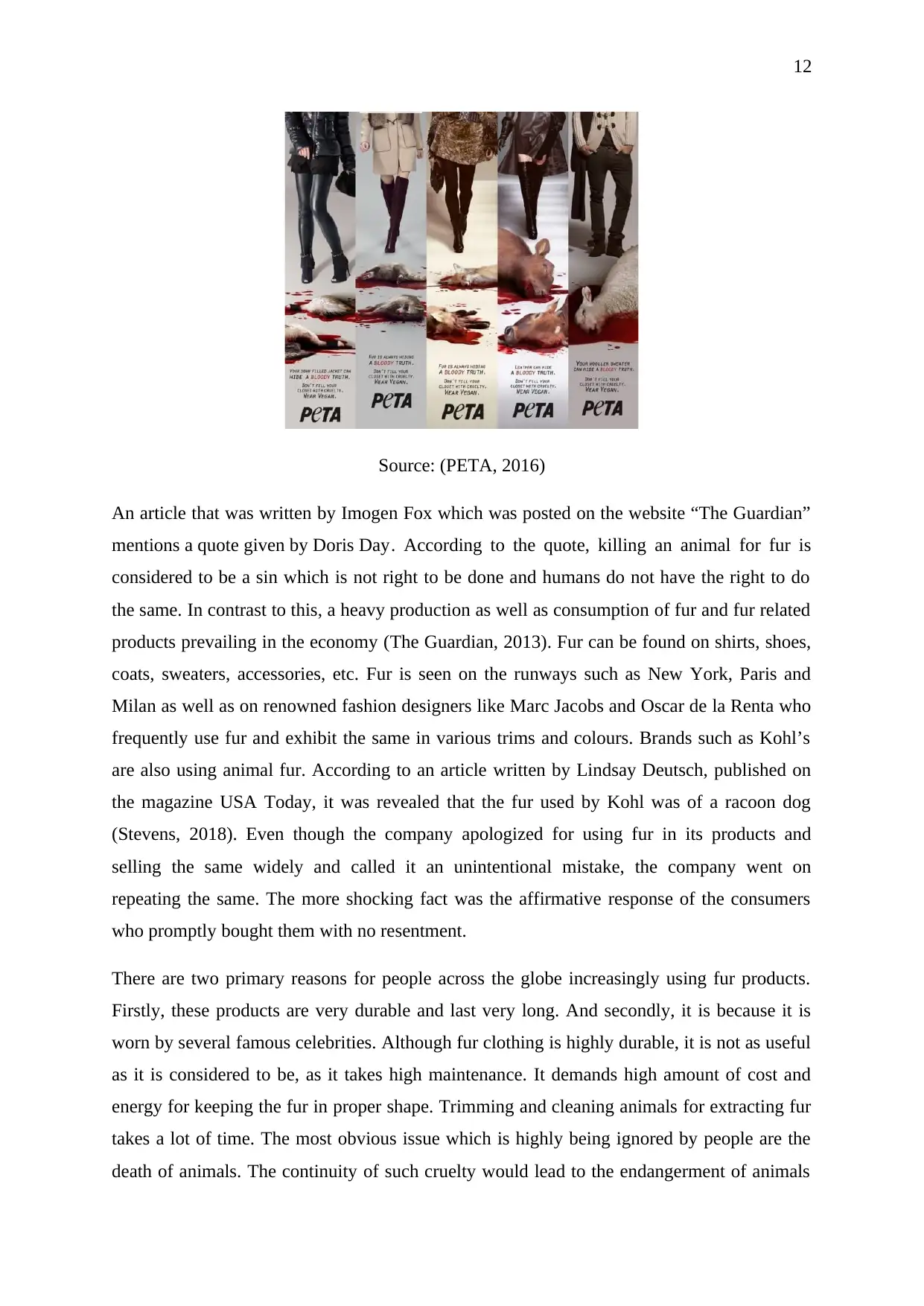
12
Source: (PETA, 2016)
An article that was written by Imogen Fox which was posted on the website “The Guardian”
mentions a quote given by Doris Day. According to the quote, killing an animal for fur is
considered to be a sin which is not right to be done and humans do not have the right to do
the same. In contrast to this, a heavy production as well as consumption of fur and fur related
products prevailing in the economy (The Guardian, 2013). Fur can be found on shirts, shoes,
coats, sweaters, accessories, etc. Fur is seen on the runways such as New York, Paris and
Milan as well as on renowned fashion designers like Marc Jacobs and Oscar de la Renta who
frequently use fur and exhibit the same in various trims and colours. Brands such as Kohl’s
are also using animal fur. According to an article written by Lindsay Deutsch, published on
the magazine USA Today, it was revealed that the fur used by Kohl was of a racoon dog
(Stevens, 2018). Even though the company apologized for using fur in its products and
selling the same widely and called it an unintentional mistake, the company went on
repeating the same. The more shocking fact was the affirmative response of the consumers
who promptly bought them with no resentment.
There are two primary reasons for people across the globe increasingly using fur products.
Firstly, these products are very durable and last very long. And secondly, it is because it is
worn by several famous celebrities. Although fur clothing is highly durable, it is not as useful
as it is considered to be, as it takes high maintenance. It demands high amount of cost and
energy for keeping the fur in proper shape. Trimming and cleaning animals for extracting fur
takes a lot of time. The most obvious issue which is highly being ignored by people are the
death of animals. The continuity of such cruelty would lead to the endangerment of animals
Source: (PETA, 2016)
An article that was written by Imogen Fox which was posted on the website “The Guardian”
mentions a quote given by Doris Day. According to the quote, killing an animal for fur is
considered to be a sin which is not right to be done and humans do not have the right to do
the same. In contrast to this, a heavy production as well as consumption of fur and fur related
products prevailing in the economy (The Guardian, 2013). Fur can be found on shirts, shoes,
coats, sweaters, accessories, etc. Fur is seen on the runways such as New York, Paris and
Milan as well as on renowned fashion designers like Marc Jacobs and Oscar de la Renta who
frequently use fur and exhibit the same in various trims and colours. Brands such as Kohl’s
are also using animal fur. According to an article written by Lindsay Deutsch, published on
the magazine USA Today, it was revealed that the fur used by Kohl was of a racoon dog
(Stevens, 2018). Even though the company apologized for using fur in its products and
selling the same widely and called it an unintentional mistake, the company went on
repeating the same. The more shocking fact was the affirmative response of the consumers
who promptly bought them with no resentment.
There are two primary reasons for people across the globe increasingly using fur products.
Firstly, these products are very durable and last very long. And secondly, it is because it is
worn by several famous celebrities. Although fur clothing is highly durable, it is not as useful
as it is considered to be, as it takes high maintenance. It demands high amount of cost and
energy for keeping the fur in proper shape. Trimming and cleaning animals for extracting fur
takes a lot of time. The most obvious issue which is highly being ignored by people are the
death of animals. The continuity of such cruelty would lead to the endangerment of animals
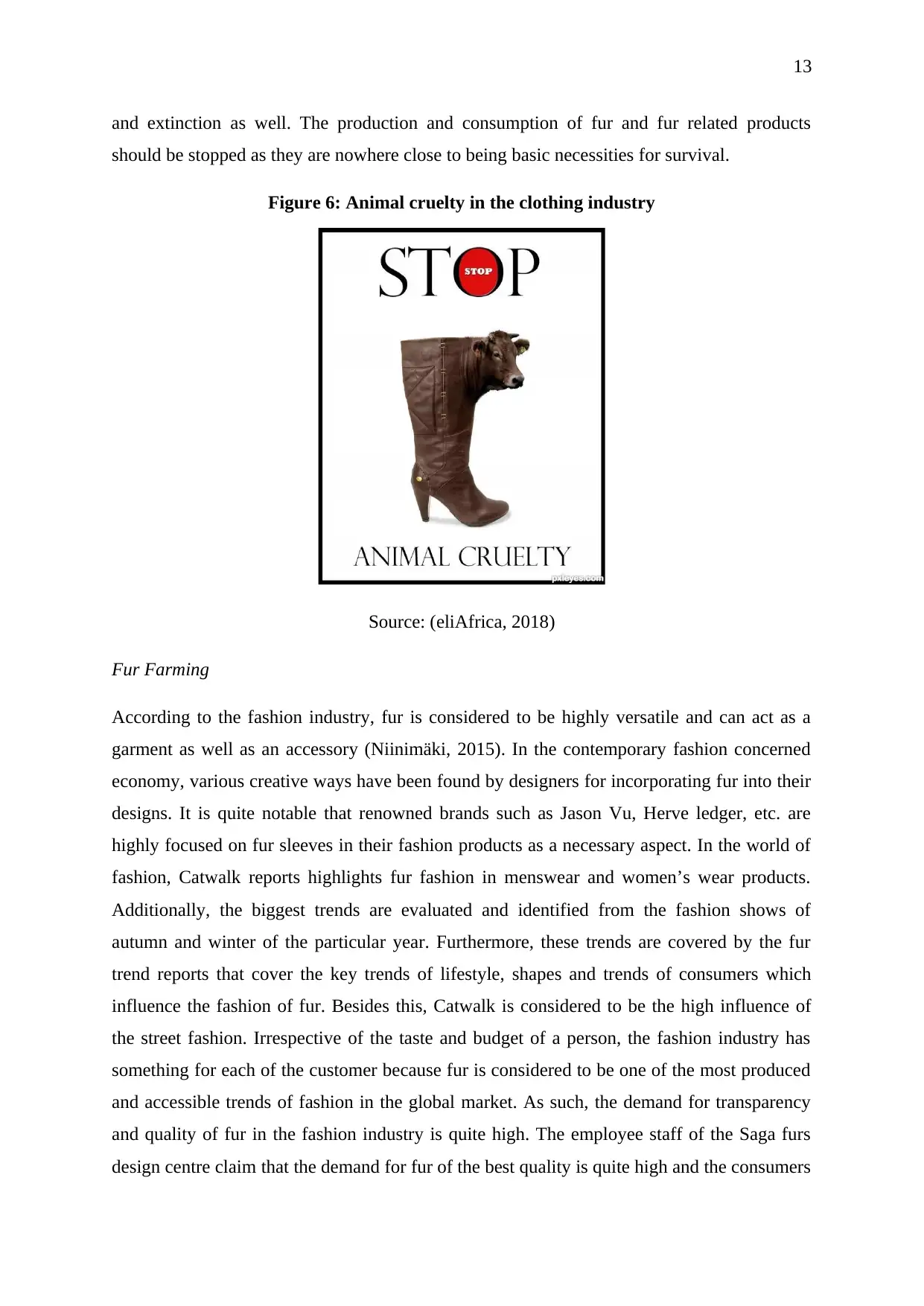
13
and extinction as well. The production and consumption of fur and fur related products
should be stopped as they are nowhere close to being basic necessities for survival.
Figure 6: Animal cruelty in the clothing industry
Source: (eliAfrica, 2018)
Fur Farming
According to the fashion industry, fur is considered to be highly versatile and can act as a
garment as well as an accessory (Niinimäki, 2015). In the contemporary fashion concerned
economy, various creative ways have been found by designers for incorporating fur into their
designs. It is quite notable that renowned brands such as Jason Vu, Herve ledger, etc. are
highly focused on fur sleeves in their fashion products as a necessary aspect. In the world of
fashion, Catwalk reports highlights fur fashion in menswear and women’s wear products.
Additionally, the biggest trends are evaluated and identified from the fashion shows of
autumn and winter of the particular year. Furthermore, these trends are covered by the fur
trend reports that cover the key trends of lifestyle, shapes and trends of consumers which
influence the fashion of fur. Besides this, Catwalk is considered to be the high influence of
the street fashion. Irrespective of the taste and budget of a person, the fashion industry has
something for each of the customer because fur is considered to be one of the most produced
and accessible trends of fashion in the global market. As such, the demand for transparency
and quality of fur in the fashion industry is quite high. The employee staff of the Saga furs
design centre claim that the demand for fur of the best quality is quite high and the consumers
and extinction as well. The production and consumption of fur and fur related products
should be stopped as they are nowhere close to being basic necessities for survival.
Figure 6: Animal cruelty in the clothing industry
Source: (eliAfrica, 2018)
Fur Farming
According to the fashion industry, fur is considered to be highly versatile and can act as a
garment as well as an accessory (Niinimäki, 2015). In the contemporary fashion concerned
economy, various creative ways have been found by designers for incorporating fur into their
designs. It is quite notable that renowned brands such as Jason Vu, Herve ledger, etc. are
highly focused on fur sleeves in their fashion products as a necessary aspect. In the world of
fashion, Catwalk reports highlights fur fashion in menswear and women’s wear products.
Additionally, the biggest trends are evaluated and identified from the fashion shows of
autumn and winter of the particular year. Furthermore, these trends are covered by the fur
trend reports that cover the key trends of lifestyle, shapes and trends of consumers which
influence the fashion of fur. Besides this, Catwalk is considered to be the high influence of
the street fashion. Irrespective of the taste and budget of a person, the fashion industry has
something for each of the customer because fur is considered to be one of the most produced
and accessible trends of fashion in the global market. As such, the demand for transparency
and quality of fur in the fashion industry is quite high. The employee staff of the Saga furs
design centre claim that the demand for fur of the best quality is quite high and the consumers
Paraphrase This Document
Need a fresh take? Get an instant paraphrase of this document with our AI Paraphraser
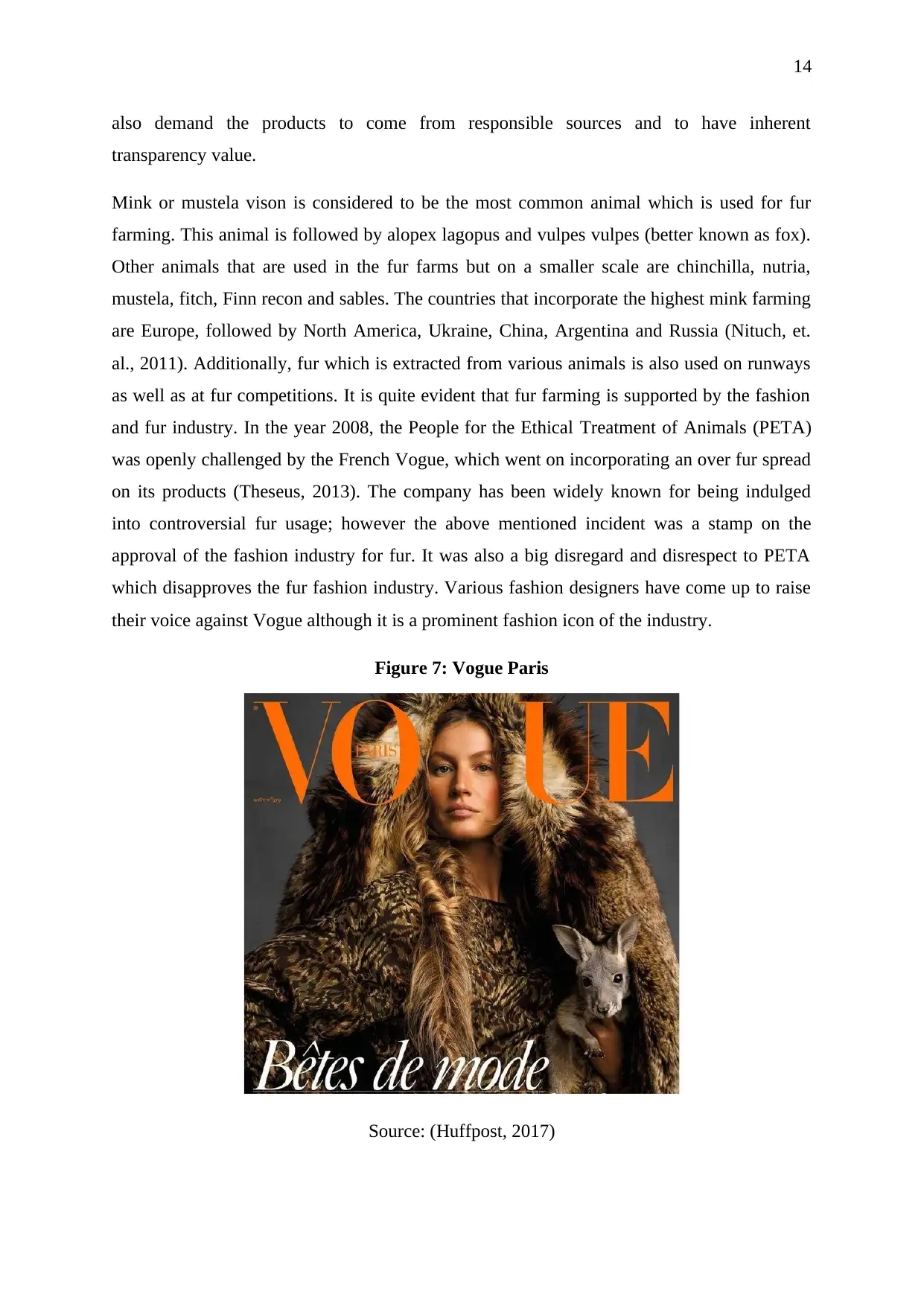
14
also demand the products to come from responsible sources and to have inherent
transparency value.
Mink or mustela vison is considered to be the most common animal which is used for fur
farming. This animal is followed by alopex lagopus and vulpes vulpes (better known as fox).
Other animals that are used in the fur farms but on a smaller scale are chinchilla, nutria,
mustela, fitch, Finn recon and sables. The countries that incorporate the highest mink farming
are Europe, followed by North America, Ukraine, China, Argentina and Russia (Nituch, et.
al., 2011). Additionally, fur which is extracted from various animals is also used on runways
as well as at fur competitions. It is quite evident that fur farming is supported by the fashion
and fur industry. In the year 2008, the People for the Ethical Treatment of Animals (PETA)
was openly challenged by the French Vogue, which went on incorporating an over fur spread
on its products (Theseus, 2013). The company has been widely known for being indulged
into controversial fur usage; however the above mentioned incident was a stamp on the
approval of the fashion industry for fur. It was also a big disregard and disrespect to PETA
which disapproves the fur fashion industry. Various fashion designers have come up to raise
their voice against Vogue although it is a prominent fashion icon of the industry.
Figure 7: Vogue Paris
Source: (Huffpost, 2017)
also demand the products to come from responsible sources and to have inherent
transparency value.
Mink or mustela vison is considered to be the most common animal which is used for fur
farming. This animal is followed by alopex lagopus and vulpes vulpes (better known as fox).
Other animals that are used in the fur farms but on a smaller scale are chinchilla, nutria,
mustela, fitch, Finn recon and sables. The countries that incorporate the highest mink farming
are Europe, followed by North America, Ukraine, China, Argentina and Russia (Nituch, et.
al., 2011). Additionally, fur which is extracted from various animals is also used on runways
as well as at fur competitions. It is quite evident that fur farming is supported by the fashion
and fur industry. In the year 2008, the People for the Ethical Treatment of Animals (PETA)
was openly challenged by the French Vogue, which went on incorporating an over fur spread
on its products (Theseus, 2013). The company has been widely known for being indulged
into controversial fur usage; however the above mentioned incident was a stamp on the
approval of the fashion industry for fur. It was also a big disregard and disrespect to PETA
which disapproves the fur fashion industry. Various fashion designers have come up to raise
their voice against Vogue although it is a prominent fashion icon of the industry.
Figure 7: Vogue Paris
Source: (Huffpost, 2017)
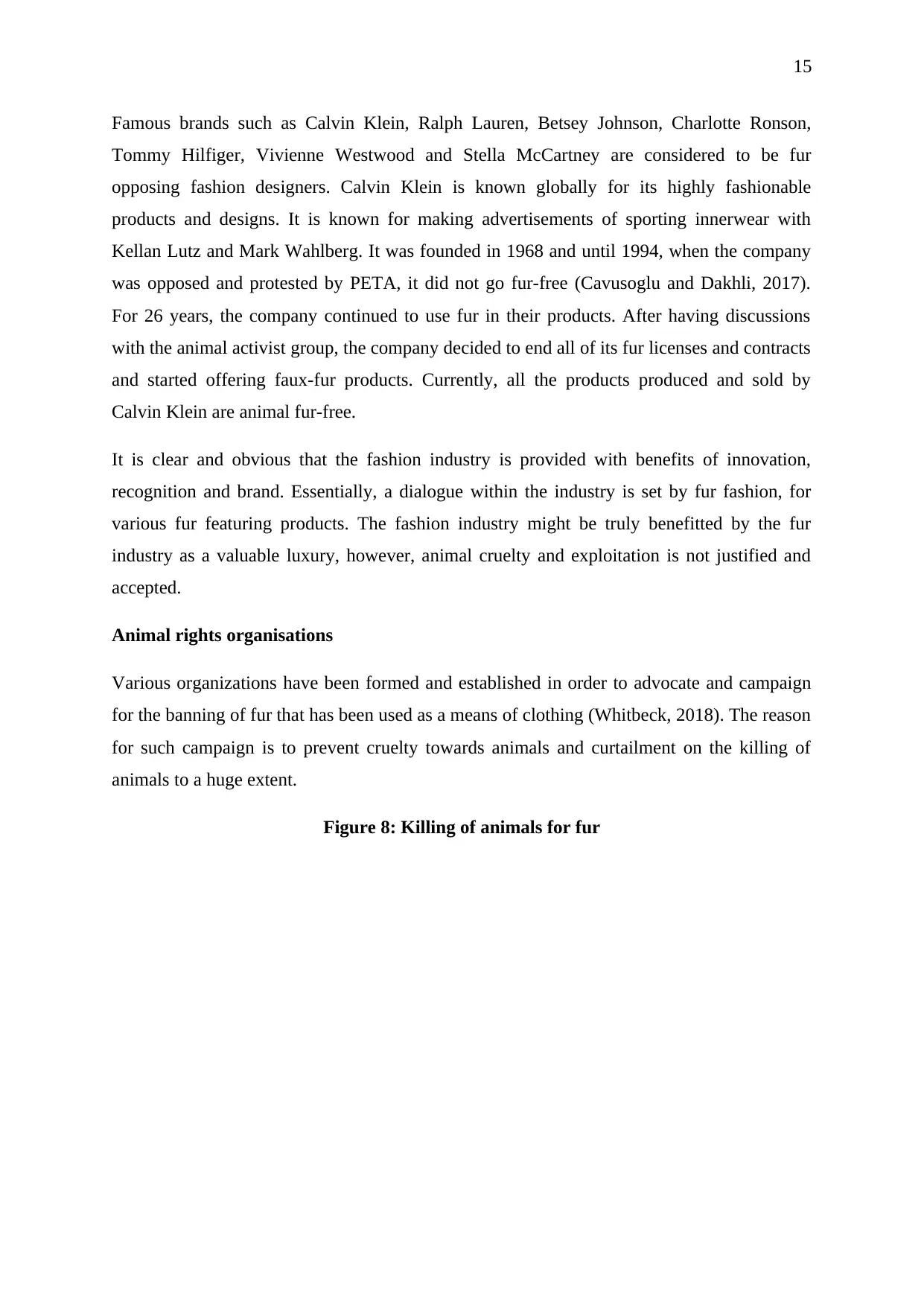
15
Famous brands such as Calvin Klein, Ralph Lauren, Betsey Johnson, Charlotte Ronson,
Tommy Hilfiger, Vivienne Westwood and Stella McCartney are considered to be fur
opposing fashion designers. Calvin Klein is known globally for its highly fashionable
products and designs. It is known for making advertisements of sporting innerwear with
Kellan Lutz and Mark Wahlberg. It was founded in 1968 and until 1994, when the company
was opposed and protested by PETA, it did not go fur-free (Cavusoglu and Dakhli, 2017).
For 26 years, the company continued to use fur in their products. After having discussions
with the animal activist group, the company decided to end all of its fur licenses and contracts
and started offering faux-fur products. Currently, all the products produced and sold by
Calvin Klein are animal fur-free.
It is clear and obvious that the fashion industry is provided with benefits of innovation,
recognition and brand. Essentially, a dialogue within the industry is set by fur fashion, for
various fur featuring products. The fashion industry might be truly benefitted by the fur
industry as a valuable luxury, however, animal cruelty and exploitation is not justified and
accepted.
Animal rights organisations
Various organizations have been formed and established in order to advocate and campaign
for the banning of fur that has been used as a means of clothing (Whitbeck, 2018). The reason
for such campaign is to prevent cruelty towards animals and curtailment on the killing of
animals to a huge extent.
Figure 8: Killing of animals for fur
Famous brands such as Calvin Klein, Ralph Lauren, Betsey Johnson, Charlotte Ronson,
Tommy Hilfiger, Vivienne Westwood and Stella McCartney are considered to be fur
opposing fashion designers. Calvin Klein is known globally for its highly fashionable
products and designs. It is known for making advertisements of sporting innerwear with
Kellan Lutz and Mark Wahlberg. It was founded in 1968 and until 1994, when the company
was opposed and protested by PETA, it did not go fur-free (Cavusoglu and Dakhli, 2017).
For 26 years, the company continued to use fur in their products. After having discussions
with the animal activist group, the company decided to end all of its fur licenses and contracts
and started offering faux-fur products. Currently, all the products produced and sold by
Calvin Klein are animal fur-free.
It is clear and obvious that the fashion industry is provided with benefits of innovation,
recognition and brand. Essentially, a dialogue within the industry is set by fur fashion, for
various fur featuring products. The fashion industry might be truly benefitted by the fur
industry as a valuable luxury, however, animal cruelty and exploitation is not justified and
accepted.
Animal rights organisations
Various organizations have been formed and established in order to advocate and campaign
for the banning of fur that has been used as a means of clothing (Whitbeck, 2018). The reason
for such campaign is to prevent cruelty towards animals and curtailment on the killing of
animals to a huge extent.
Figure 8: Killing of animals for fur
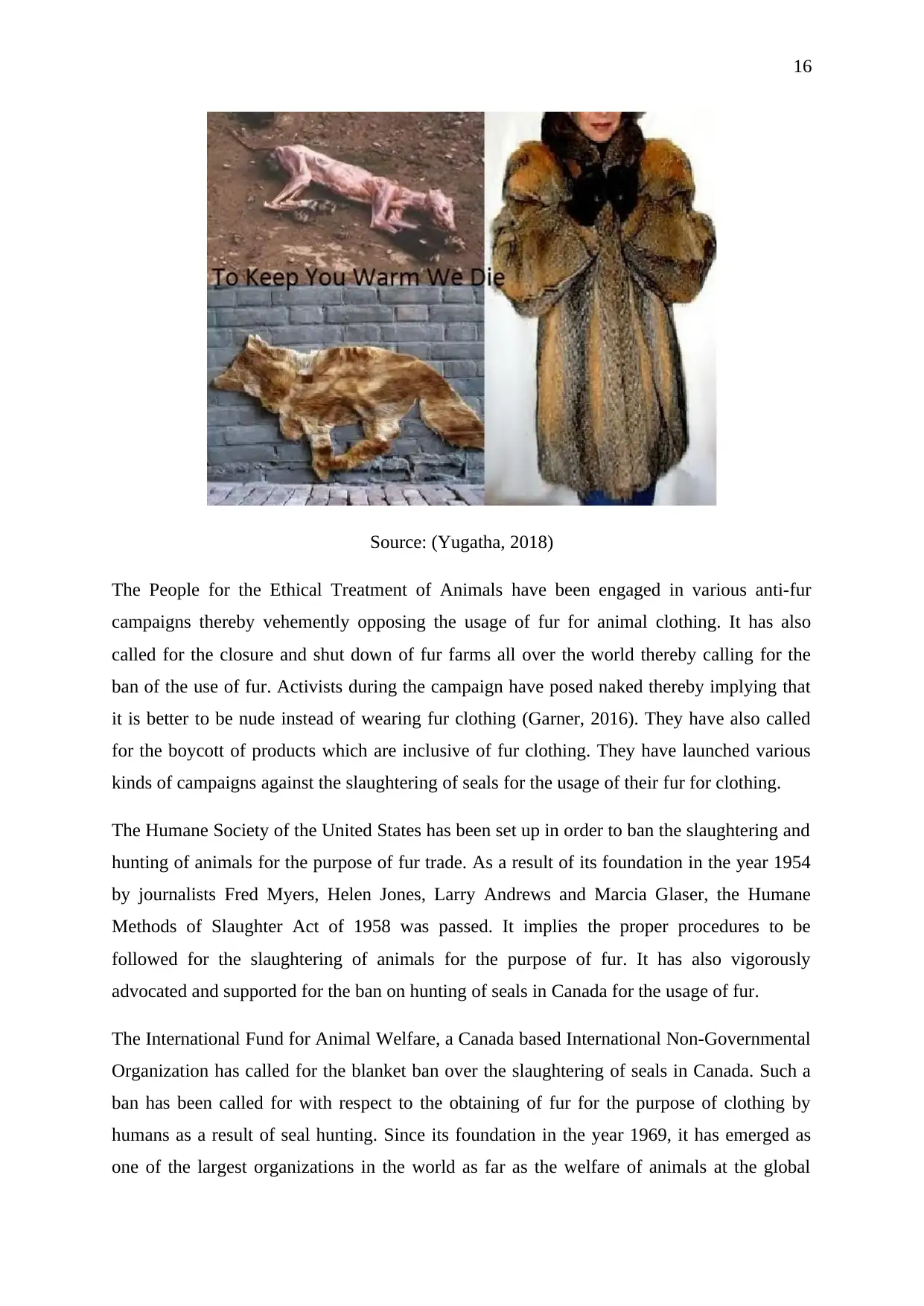
16
Source: (Yugatha, 2018)
The People for the Ethical Treatment of Animals have been engaged in various anti-fur
campaigns thereby vehemently opposing the usage of fur for animal clothing. It has also
called for the closure and shut down of fur farms all over the world thereby calling for the
ban of the use of fur. Activists during the campaign have posed naked thereby implying that
it is better to be nude instead of wearing fur clothing (Garner, 2016). They have also called
for the boycott of products which are inclusive of fur clothing. They have launched various
kinds of campaigns against the slaughtering of seals for the usage of their fur for clothing.
The Humane Society of the United States has been set up in order to ban the slaughtering and
hunting of animals for the purpose of fur trade. As a result of its foundation in the year 1954
by journalists Fred Myers, Helen Jones, Larry Andrews and Marcia Glaser, the Humane
Methods of Slaughter Act of 1958 was passed. It implies the proper procedures to be
followed for the slaughtering of animals for the purpose of fur. It has also vigorously
advocated and supported for the ban on hunting of seals in Canada for the usage of fur.
The International Fund for Animal Welfare, a Canada based International Non-Governmental
Organization has called for the blanket ban over the slaughtering of seals in Canada. Such a
ban has been called for with respect to the obtaining of fur for the purpose of clothing by
humans as a result of seal hunting. Since its foundation in the year 1969, it has emerged as
one of the largest organizations in the world as far as the welfare of animals at the global
Source: (Yugatha, 2018)
The People for the Ethical Treatment of Animals have been engaged in various anti-fur
campaigns thereby vehemently opposing the usage of fur for animal clothing. It has also
called for the closure and shut down of fur farms all over the world thereby calling for the
ban of the use of fur. Activists during the campaign have posed naked thereby implying that
it is better to be nude instead of wearing fur clothing (Garner, 2016). They have also called
for the boycott of products which are inclusive of fur clothing. They have launched various
kinds of campaigns against the slaughtering of seals for the usage of their fur for clothing.
The Humane Society of the United States has been set up in order to ban the slaughtering and
hunting of animals for the purpose of fur trade. As a result of its foundation in the year 1954
by journalists Fred Myers, Helen Jones, Larry Andrews and Marcia Glaser, the Humane
Methods of Slaughter Act of 1958 was passed. It implies the proper procedures to be
followed for the slaughtering of animals for the purpose of fur. It has also vigorously
advocated and supported for the ban on hunting of seals in Canada for the usage of fur.
The International Fund for Animal Welfare, a Canada based International Non-Governmental
Organization has called for the blanket ban over the slaughtering of seals in Canada. Such a
ban has been called for with respect to the obtaining of fur for the purpose of clothing by
humans as a result of seal hunting. Since its foundation in the year 1969, it has emerged as
one of the largest organizations in the world as far as the welfare of animals at the global
Secure Best Marks with AI Grader
Need help grading? Try our AI Grader for instant feedback on your assignments.
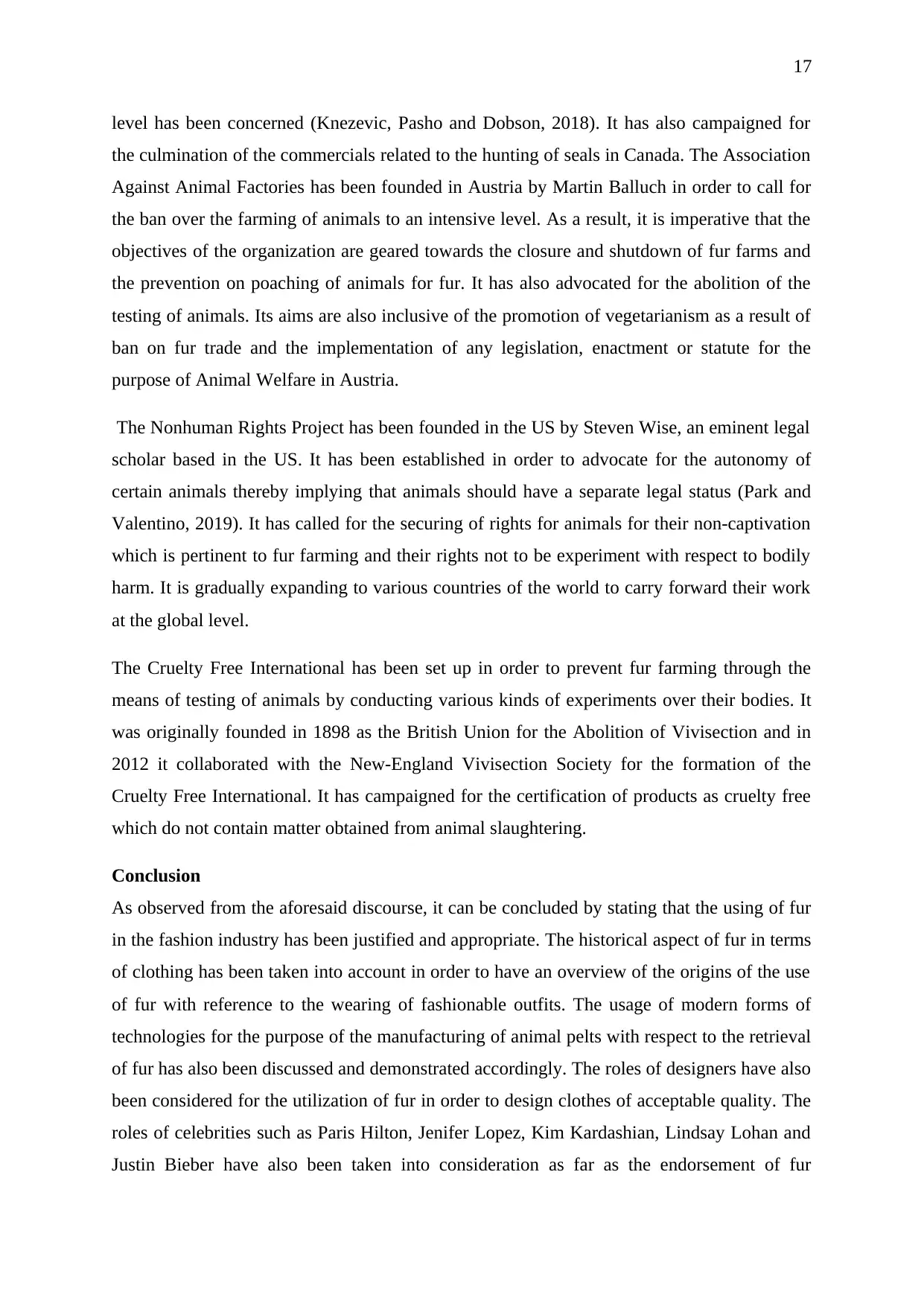
17
level has been concerned (Knezevic, Pasho and Dobson, 2018). It has also campaigned for
the culmination of the commercials related to the hunting of seals in Canada. The Association
Against Animal Factories has been founded in Austria by Martin Balluch in order to call for
the ban over the farming of animals to an intensive level. As a result, it is imperative that the
objectives of the organization are geared towards the closure and shutdown of fur farms and
the prevention on poaching of animals for fur. It has also advocated for the abolition of the
testing of animals. Its aims are also inclusive of the promotion of vegetarianism as a result of
ban on fur trade and the implementation of any legislation, enactment or statute for the
purpose of Animal Welfare in Austria.
The Nonhuman Rights Project has been founded in the US by Steven Wise, an eminent legal
scholar based in the US. It has been established in order to advocate for the autonomy of
certain animals thereby implying that animals should have a separate legal status (Park and
Valentino, 2019). It has called for the securing of rights for animals for their non-captivation
which is pertinent to fur farming and their rights not to be experiment with respect to bodily
harm. It is gradually expanding to various countries of the world to carry forward their work
at the global level.
The Cruelty Free International has been set up in order to prevent fur farming through the
means of testing of animals by conducting various kinds of experiments over their bodies. It
was originally founded in 1898 as the British Union for the Abolition of Vivisection and in
2012 it collaborated with the New-England Vivisection Society for the formation of the
Cruelty Free International. It has campaigned for the certification of products as cruelty free
which do not contain matter obtained from animal slaughtering.
Conclusion
As observed from the aforesaid discourse, it can be concluded by stating that the using of fur
in the fashion industry has been justified and appropriate. The historical aspect of fur in terms
of clothing has been taken into account in order to have an overview of the origins of the use
of fur with reference to the wearing of fashionable outfits. The usage of modern forms of
technologies for the purpose of the manufacturing of animal pelts with respect to the retrieval
of fur has also been discussed and demonstrated accordingly. The roles of designers have also
been considered for the utilization of fur in order to design clothes of acceptable quality. The
roles of celebrities such as Paris Hilton, Jenifer Lopez, Kim Kardashian, Lindsay Lohan and
Justin Bieber have also been taken into consideration as far as the endorsement of fur
level has been concerned (Knezevic, Pasho and Dobson, 2018). It has also campaigned for
the culmination of the commercials related to the hunting of seals in Canada. The Association
Against Animal Factories has been founded in Austria by Martin Balluch in order to call for
the ban over the farming of animals to an intensive level. As a result, it is imperative that the
objectives of the organization are geared towards the closure and shutdown of fur farms and
the prevention on poaching of animals for fur. It has also advocated for the abolition of the
testing of animals. Its aims are also inclusive of the promotion of vegetarianism as a result of
ban on fur trade and the implementation of any legislation, enactment or statute for the
purpose of Animal Welfare in Austria.
The Nonhuman Rights Project has been founded in the US by Steven Wise, an eminent legal
scholar based in the US. It has been established in order to advocate for the autonomy of
certain animals thereby implying that animals should have a separate legal status (Park and
Valentino, 2019). It has called for the securing of rights for animals for their non-captivation
which is pertinent to fur farming and their rights not to be experiment with respect to bodily
harm. It is gradually expanding to various countries of the world to carry forward their work
at the global level.
The Cruelty Free International has been set up in order to prevent fur farming through the
means of testing of animals by conducting various kinds of experiments over their bodies. It
was originally founded in 1898 as the British Union for the Abolition of Vivisection and in
2012 it collaborated with the New-England Vivisection Society for the formation of the
Cruelty Free International. It has campaigned for the certification of products as cruelty free
which do not contain matter obtained from animal slaughtering.
Conclusion
As observed from the aforesaid discourse, it can be concluded by stating that the using of fur
in the fashion industry has been justified and appropriate. The historical aspect of fur in terms
of clothing has been taken into account in order to have an overview of the origins of the use
of fur with reference to the wearing of fashionable outfits. The usage of modern forms of
technologies for the purpose of the manufacturing of animal pelts with respect to the retrieval
of fur has also been discussed and demonstrated accordingly. The roles of designers have also
been considered for the utilization of fur in order to design clothes of acceptable quality. The
roles of celebrities such as Paris Hilton, Jenifer Lopez, Kim Kardashian, Lindsay Lohan and
Justin Bieber have also been taken into consideration as far as the endorsement of fur
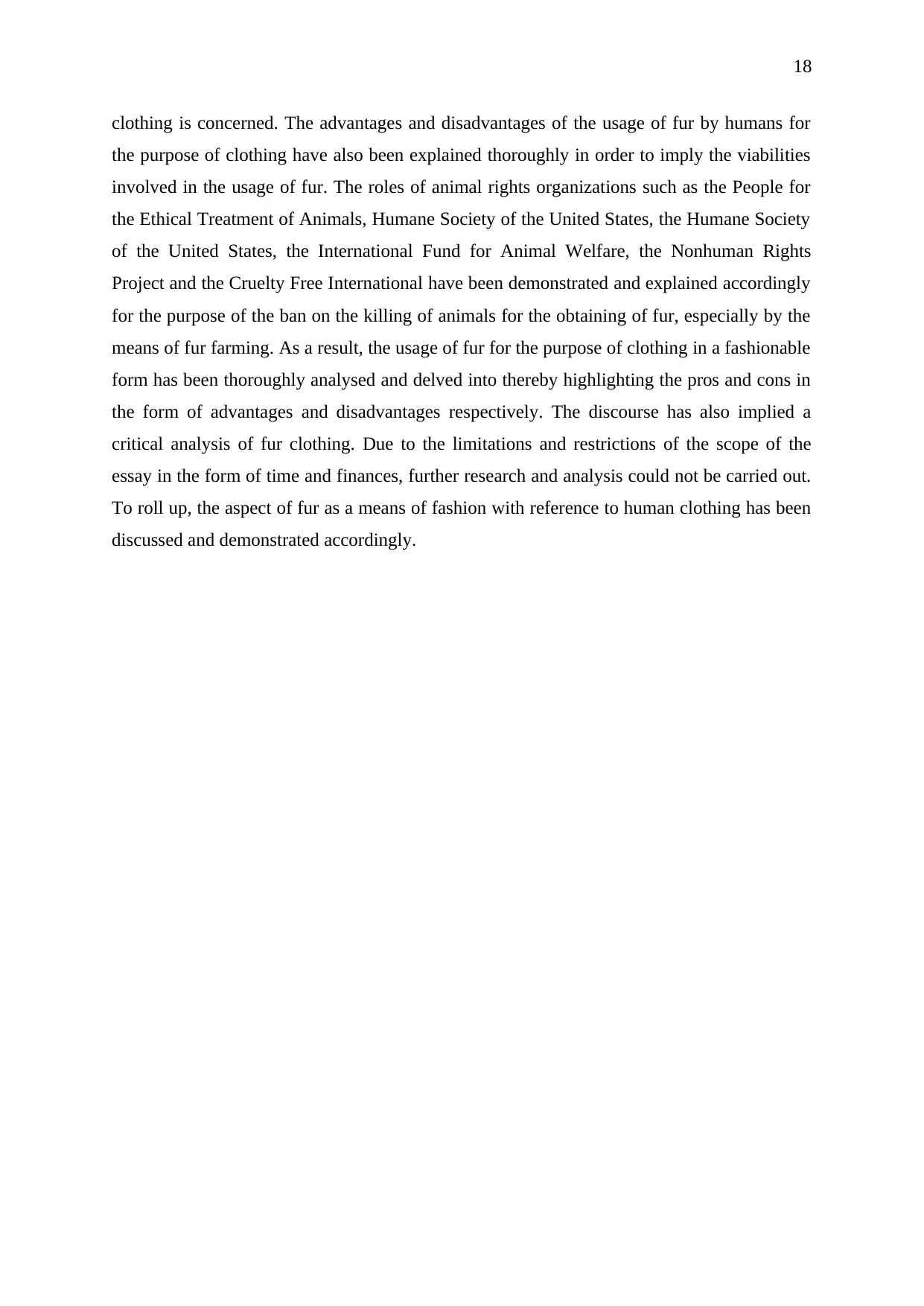
18
clothing is concerned. The advantages and disadvantages of the usage of fur by humans for
the purpose of clothing have also been explained thoroughly in order to imply the viabilities
involved in the usage of fur. The roles of animal rights organizations such as the People for
the Ethical Treatment of Animals, Humane Society of the United States, the Humane Society
of the United States, the International Fund for Animal Welfare, the Nonhuman Rights
Project and the Cruelty Free International have been demonstrated and explained accordingly
for the purpose of the ban on the killing of animals for the obtaining of fur, especially by the
means of fur farming. As a result, the usage of fur for the purpose of clothing in a fashionable
form has been thoroughly analysed and delved into thereby highlighting the pros and cons in
the form of advantages and disadvantages respectively. The discourse has also implied a
critical analysis of fur clothing. Due to the limitations and restrictions of the scope of the
essay in the form of time and finances, further research and analysis could not be carried out.
To roll up, the aspect of fur as a means of fashion with reference to human clothing has been
discussed and demonstrated accordingly.
clothing is concerned. The advantages and disadvantages of the usage of fur by humans for
the purpose of clothing have also been explained thoroughly in order to imply the viabilities
involved in the usage of fur. The roles of animal rights organizations such as the People for
the Ethical Treatment of Animals, Humane Society of the United States, the Humane Society
of the United States, the International Fund for Animal Welfare, the Nonhuman Rights
Project and the Cruelty Free International have been demonstrated and explained accordingly
for the purpose of the ban on the killing of animals for the obtaining of fur, especially by the
means of fur farming. As a result, the usage of fur for the purpose of clothing in a fashionable
form has been thoroughly analysed and delved into thereby highlighting the pros and cons in
the form of advantages and disadvantages respectively. The discourse has also implied a
critical analysis of fur clothing. Due to the limitations and restrictions of the scope of the
essay in the form of time and finances, further research and analysis could not be carried out.
To roll up, the aspect of fur as a means of fashion with reference to human clothing has been
discussed and demonstrated accordingly.
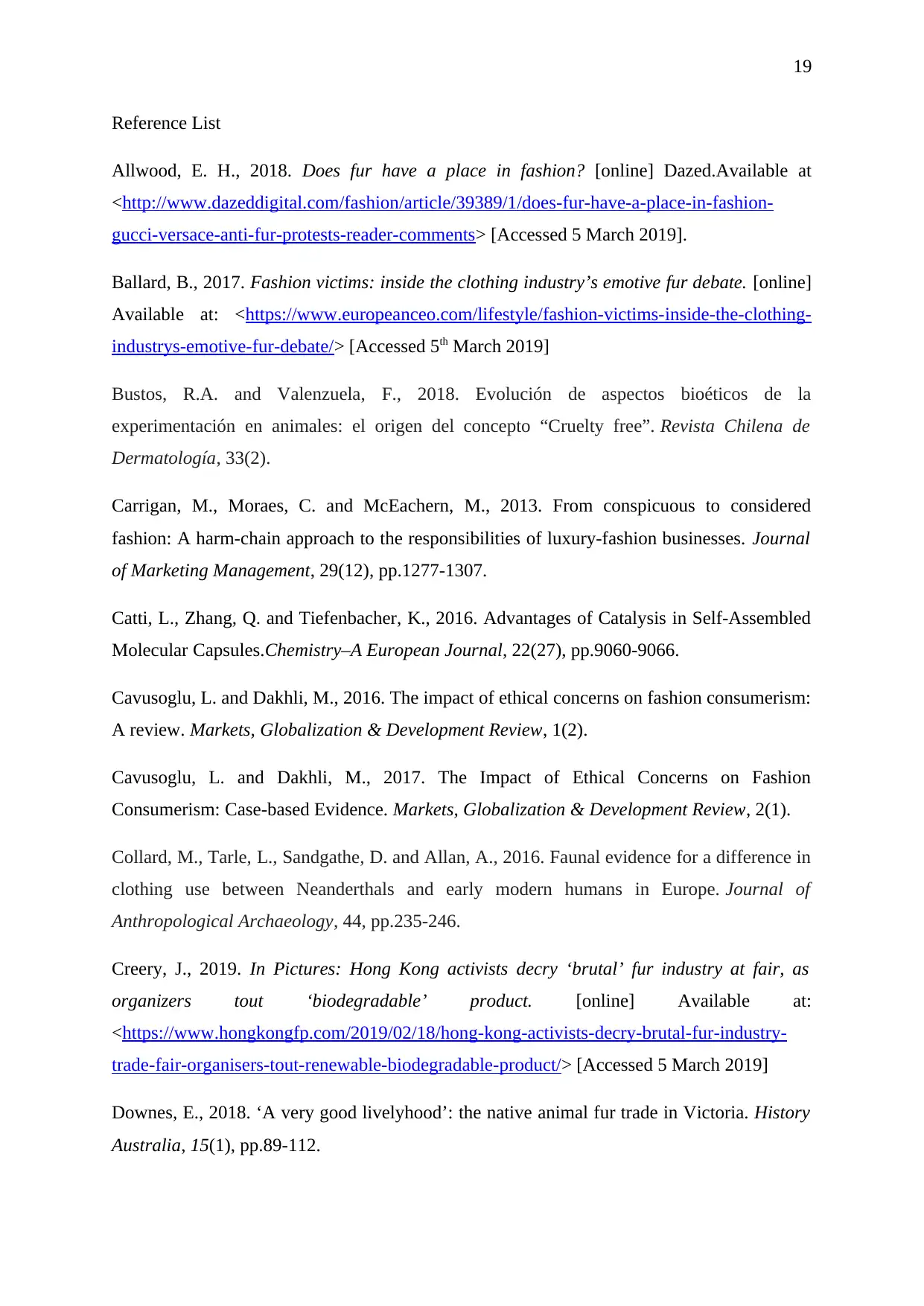
19
Reference List
Allwood, E. H., 2018. Does fur have a place in fashion? [online] Dazed.Available at
<http://www.dazeddigital.com/fashion/article/39389/1/does-fur-have-a-place-in-fashion-
gucci-versace-anti-fur-protests-reader-comments> [Accessed 5 March 2019].
Ballard, B., 2017. Fashion victims: inside the clothing industry’s emotive fur debate. [online]
Available at: <https://www.europeanceo.com/lifestyle/fashion-victims-inside-the-clothing-
industrys-emotive-fur-debate/> [Accessed 5th March 2019]
Bustos, R.A. and Valenzuela, F., 2018. Evolución de aspectos bioéticos de la
experimentación en animales: el origen del concepto “Cruelty free”. Revista Chilena de
Dermatología, 33(2).
Carrigan, M., Moraes, C. and McEachern, M., 2013. From conspicuous to considered
fashion: A harm-chain approach to the responsibilities of luxury-fashion businesses. Journal
of Marketing Management, 29(12), pp.1277-1307.
Catti, L., Zhang, Q. and Tiefenbacher, K., 2016. Advantages of Catalysis in Self‐Assembled
Molecular Capsules.Chemistry–A European Journal, 22(27), pp.9060-9066.
Cavusoglu, L. and Dakhli, M., 2016. The impact of ethical concerns on fashion consumerism:
A review. Markets, Globalization & Development Review, 1(2).
Cavusoglu, L. and Dakhli, M., 2017. The Impact of Ethical Concerns on Fashion
Consumerism: Case-based Evidence. Markets, Globalization & Development Review, 2(1).
Collard, M., Tarle, L., Sandgathe, D. and Allan, A., 2016. Faunal evidence for a difference in
clothing use between Neanderthals and early modern humans in Europe. Journal of
Anthropological Archaeology, 44, pp.235-246.
Creery, J., 2019. In Pictures: Hong Kong activists decry ‘brutal’ fur industry at fair, as
organizers tout ‘biodegradable’ product. [online] Available at:
<https://www.hongkongfp.com/2019/02/18/hong-kong-activists-decry-brutal-fur-industry-
trade-fair-organisers-tout-renewable-biodegradable-product/> [Accessed 5 March 2019]
Downes, E., 2018. ‘A very good livelyhood’: the native animal fur trade in Victoria. History
Australia, 15(1), pp.89-112.
Reference List
Allwood, E. H., 2018. Does fur have a place in fashion? [online] Dazed.Available at
<http://www.dazeddigital.com/fashion/article/39389/1/does-fur-have-a-place-in-fashion-
gucci-versace-anti-fur-protests-reader-comments> [Accessed 5 March 2019].
Ballard, B., 2017. Fashion victims: inside the clothing industry’s emotive fur debate. [online]
Available at: <https://www.europeanceo.com/lifestyle/fashion-victims-inside-the-clothing-
industrys-emotive-fur-debate/> [Accessed 5th March 2019]
Bustos, R.A. and Valenzuela, F., 2018. Evolución de aspectos bioéticos de la
experimentación en animales: el origen del concepto “Cruelty free”. Revista Chilena de
Dermatología, 33(2).
Carrigan, M., Moraes, C. and McEachern, M., 2013. From conspicuous to considered
fashion: A harm-chain approach to the responsibilities of luxury-fashion businesses. Journal
of Marketing Management, 29(12), pp.1277-1307.
Catti, L., Zhang, Q. and Tiefenbacher, K., 2016. Advantages of Catalysis in Self‐Assembled
Molecular Capsules.Chemistry–A European Journal, 22(27), pp.9060-9066.
Cavusoglu, L. and Dakhli, M., 2016. The impact of ethical concerns on fashion consumerism:
A review. Markets, Globalization & Development Review, 1(2).
Cavusoglu, L. and Dakhli, M., 2017. The Impact of Ethical Concerns on Fashion
Consumerism: Case-based Evidence. Markets, Globalization & Development Review, 2(1).
Collard, M., Tarle, L., Sandgathe, D. and Allan, A., 2016. Faunal evidence for a difference in
clothing use between Neanderthals and early modern humans in Europe. Journal of
Anthropological Archaeology, 44, pp.235-246.
Creery, J., 2019. In Pictures: Hong Kong activists decry ‘brutal’ fur industry at fair, as
organizers tout ‘biodegradable’ product. [online] Available at:
<https://www.hongkongfp.com/2019/02/18/hong-kong-activists-decry-brutal-fur-industry-
trade-fair-organisers-tout-renewable-biodegradable-product/> [Accessed 5 March 2019]
Downes, E., 2018. ‘A very good livelyhood’: the native animal fur trade in Victoria. History
Australia, 15(1), pp.89-112.
Paraphrase This Document
Need a fresh take? Get an instant paraphrase of this document with our AI Paraphraser
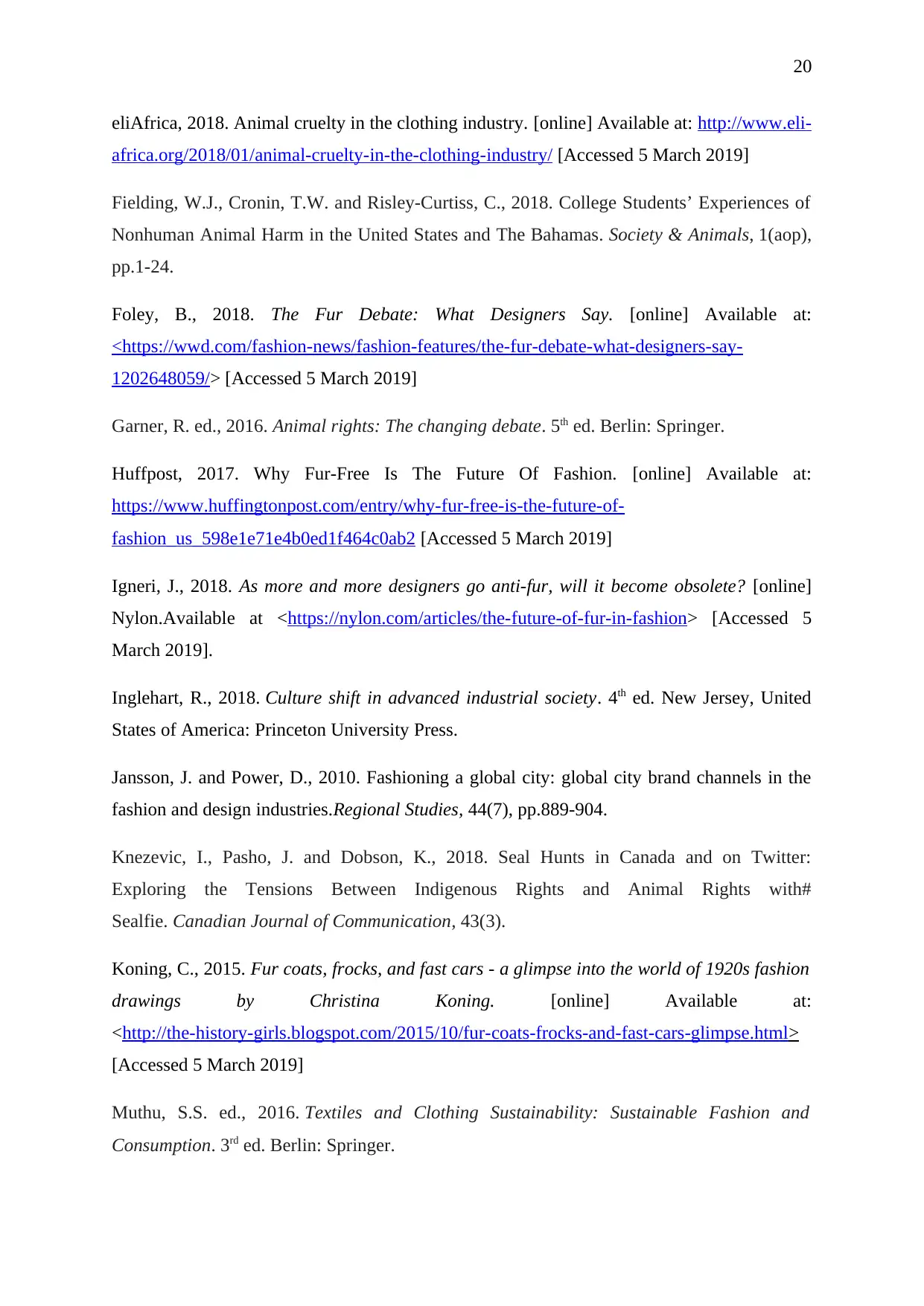
20
eliAfrica, 2018. Animal cruelty in the clothing industry. [online] Available at: http://www.eli-
africa.org/2018/01/animal-cruelty-in-the-clothing-industry/ [Accessed 5 March 2019]
Fielding, W.J., Cronin, T.W. and Risley-Curtiss, C., 2018. College Students’ Experiences of
Nonhuman Animal Harm in the United States and The Bahamas. Society & Animals, 1(aop),
pp.1-24.
Foley, B., 2018. The Fur Debate: What Designers Say. [online] Available at:
<https://wwd.com/fashion-news/fashion-features/the-fur-debate-what-designers-say-
1202648059/> [Accessed 5 March 2019]
Garner, R. ed., 2016. Animal rights: The changing debate. 5th ed. Berlin: Springer.
Huffpost, 2017. Why Fur-Free Is The Future Of Fashion. [online] Available at:
https://www.huffingtonpost.com/entry/why-fur-free-is-the-future-of-
fashion_us_598e1e71e4b0ed1f464c0ab2 [Accessed 5 March 2019]
Igneri, J., 2018. As more and more designers go anti-fur, will it become obsolete? [online]
Nylon.Available at <https://nylon.com/articles/the-future-of-fur-in-fashion> [Accessed 5
March 2019].
Inglehart, R., 2018. Culture shift in advanced industrial society. 4th ed. New Jersey, United
States of America: Princeton University Press.
Jansson, J. and Power, D., 2010. Fashioning a global city: global city brand channels in the
fashion and design industries.Regional Studies, 44(7), pp.889-904.
Knezevic, I., Pasho, J. and Dobson, K., 2018. Seal Hunts in Canada and on Twitter:
Exploring the Tensions Between Indigenous Rights and Animal Rights with#
Sealfie. Canadian Journal of Communication, 43(3).
Koning, C., 2015. Fur coats, frocks, and fast cars - a glimpse into the world of 1920s fashion
drawings by Christina Koning. [online] Available at:
<http://the-history-girls.blogspot.com/2015/10/fur-coats-frocks-and-fast-cars-glimpse.html>
[Accessed 5 March 2019]
Muthu, S.S. ed., 2016. Textiles and Clothing Sustainability: Sustainable Fashion and
Consumption. 3rd ed. Berlin: Springer.
eliAfrica, 2018. Animal cruelty in the clothing industry. [online] Available at: http://www.eli-
africa.org/2018/01/animal-cruelty-in-the-clothing-industry/ [Accessed 5 March 2019]
Fielding, W.J., Cronin, T.W. and Risley-Curtiss, C., 2018. College Students’ Experiences of
Nonhuman Animal Harm in the United States and The Bahamas. Society & Animals, 1(aop),
pp.1-24.
Foley, B., 2018. The Fur Debate: What Designers Say. [online] Available at:
<https://wwd.com/fashion-news/fashion-features/the-fur-debate-what-designers-say-
1202648059/> [Accessed 5 March 2019]
Garner, R. ed., 2016. Animal rights: The changing debate. 5th ed. Berlin: Springer.
Huffpost, 2017. Why Fur-Free Is The Future Of Fashion. [online] Available at:
https://www.huffingtonpost.com/entry/why-fur-free-is-the-future-of-
fashion_us_598e1e71e4b0ed1f464c0ab2 [Accessed 5 March 2019]
Igneri, J., 2018. As more and more designers go anti-fur, will it become obsolete? [online]
Nylon.Available at <https://nylon.com/articles/the-future-of-fur-in-fashion> [Accessed 5
March 2019].
Inglehart, R., 2018. Culture shift in advanced industrial society. 4th ed. New Jersey, United
States of America: Princeton University Press.
Jansson, J. and Power, D., 2010. Fashioning a global city: global city brand channels in the
fashion and design industries.Regional Studies, 44(7), pp.889-904.
Knezevic, I., Pasho, J. and Dobson, K., 2018. Seal Hunts in Canada and on Twitter:
Exploring the Tensions Between Indigenous Rights and Animal Rights with#
Sealfie. Canadian Journal of Communication, 43(3).
Koning, C., 2015. Fur coats, frocks, and fast cars - a glimpse into the world of 1920s fashion
drawings by Christina Koning. [online] Available at:
<http://the-history-girls.blogspot.com/2015/10/fur-coats-frocks-and-fast-cars-glimpse.html>
[Accessed 5 March 2019]
Muthu, S.S. ed., 2016. Textiles and Clothing Sustainability: Sustainable Fashion and
Consumption. 3rd ed. Berlin: Springer.
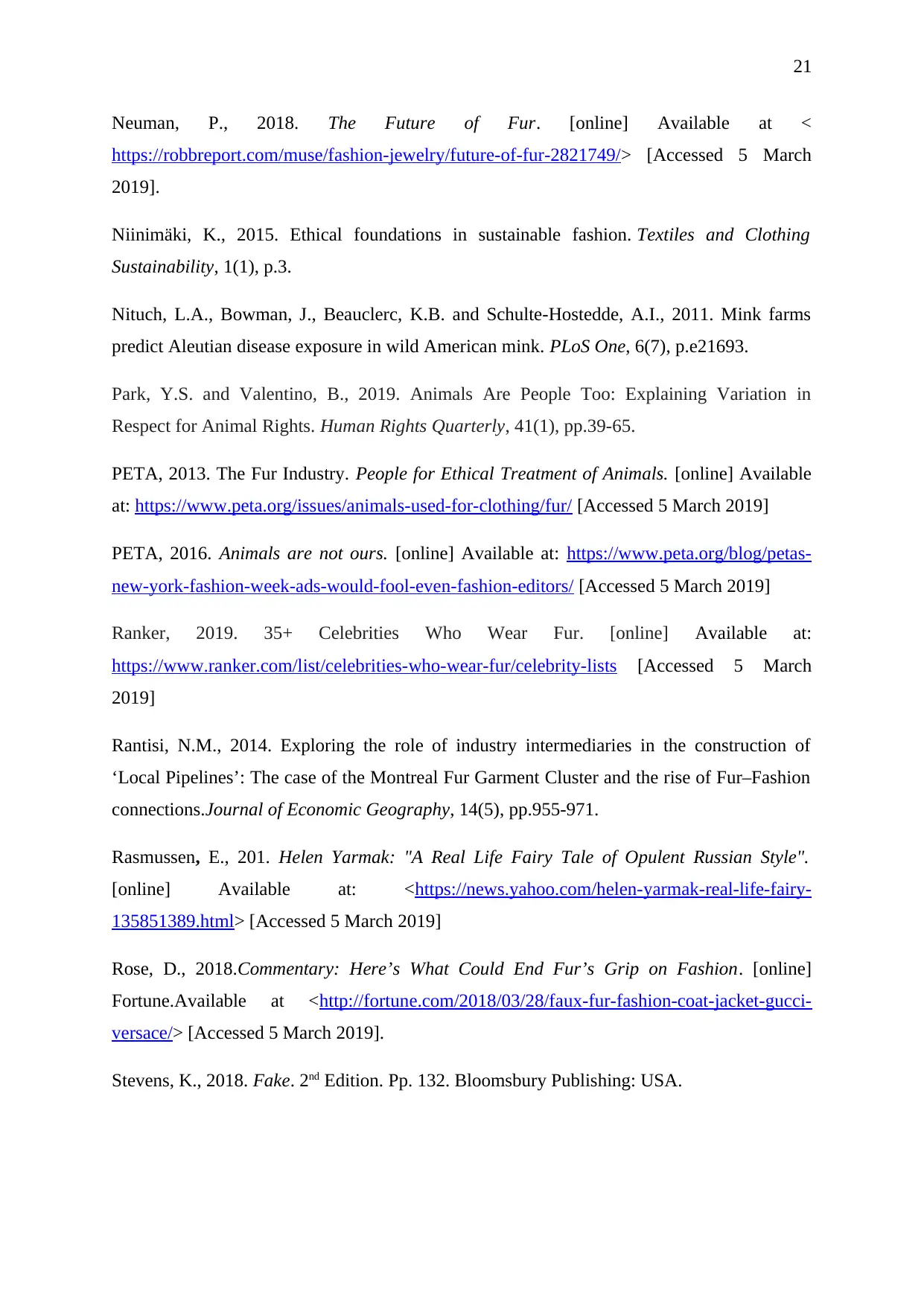
21
Neuman, P., 2018. The Future of Fur. [online] Available at <
https://robbreport.com/muse/fashion-jewelry/future-of-fur-2821749/> [Accessed 5 March
2019].
Niinimäki, K., 2015. Ethical foundations in sustainable fashion. Textiles and Clothing
Sustainability, 1(1), p.3.
Nituch, L.A., Bowman, J., Beauclerc, K.B. and Schulte-Hostedde, A.I., 2011. Mink farms
predict Aleutian disease exposure in wild American mink. PLoS One, 6(7), p.e21693.
Park, Y.S. and Valentino, B., 2019. Animals Are People Too: Explaining Variation in
Respect for Animal Rights. Human Rights Quarterly, 41(1), pp.39-65.
PETA, 2013. The Fur Industry. People for Ethical Treatment of Animals. [online] Available
at: https://www.peta.org/issues/animals-used-for-clothing/fur/ [Accessed 5 March 2019]
PETA, 2016. Animals are not ours. [online] Available at: https://www.peta.org/blog/petas-
new-york-fashion-week-ads-would-fool-even-fashion-editors/ [Accessed 5 March 2019]
Ranker, 2019. 35+ Celebrities Who Wear Fur. [online] Available at:
https://www.ranker.com/list/celebrities-who-wear-fur/celebrity-lists [Accessed 5 March
2019]
Rantisi, N.M., 2014. Exploring the role of industry intermediaries in the construction of
‘Local Pipelines’: The case of the Montreal Fur Garment Cluster and the rise of Fur–Fashion
connections.Journal of Economic Geography, 14(5), pp.955-971.
Rasmussen, E., 201. Helen Yarmak: "A Real Life Fairy Tale of Opulent Russian Style".
[online] Available at: <https://news.yahoo.com/helen-yarmak-real-life-fairy-
135851389.html> [Accessed 5 March 2019]
Rose, D., 2018.Commentary: Here’s What Could End Fur’s Grip on Fashion. [online]
Fortune.Available at <http://fortune.com/2018/03/28/faux-fur-fashion-coat-jacket-gucci-
versace/> [Accessed 5 March 2019].
Stevens, K., 2018. Fake. 2nd Edition. Pp. 132. Bloomsbury Publishing: USA.
Neuman, P., 2018. The Future of Fur. [online] Available at <
https://robbreport.com/muse/fashion-jewelry/future-of-fur-2821749/> [Accessed 5 March
2019].
Niinimäki, K., 2015. Ethical foundations in sustainable fashion. Textiles and Clothing
Sustainability, 1(1), p.3.
Nituch, L.A., Bowman, J., Beauclerc, K.B. and Schulte-Hostedde, A.I., 2011. Mink farms
predict Aleutian disease exposure in wild American mink. PLoS One, 6(7), p.e21693.
Park, Y.S. and Valentino, B., 2019. Animals Are People Too: Explaining Variation in
Respect for Animal Rights. Human Rights Quarterly, 41(1), pp.39-65.
PETA, 2013. The Fur Industry. People for Ethical Treatment of Animals. [online] Available
at: https://www.peta.org/issues/animals-used-for-clothing/fur/ [Accessed 5 March 2019]
PETA, 2016. Animals are not ours. [online] Available at: https://www.peta.org/blog/petas-
new-york-fashion-week-ads-would-fool-even-fashion-editors/ [Accessed 5 March 2019]
Ranker, 2019. 35+ Celebrities Who Wear Fur. [online] Available at:
https://www.ranker.com/list/celebrities-who-wear-fur/celebrity-lists [Accessed 5 March
2019]
Rantisi, N.M., 2014. Exploring the role of industry intermediaries in the construction of
‘Local Pipelines’: The case of the Montreal Fur Garment Cluster and the rise of Fur–Fashion
connections.Journal of Economic Geography, 14(5), pp.955-971.
Rasmussen, E., 201. Helen Yarmak: "A Real Life Fairy Tale of Opulent Russian Style".
[online] Available at: <https://news.yahoo.com/helen-yarmak-real-life-fairy-
135851389.html> [Accessed 5 March 2019]
Rose, D., 2018.Commentary: Here’s What Could End Fur’s Grip on Fashion. [online]
Fortune.Available at <http://fortune.com/2018/03/28/faux-fur-fashion-coat-jacket-gucci-
versace/> [Accessed 5 March 2019].
Stevens, K., 2018. Fake. 2nd Edition. Pp. 132. Bloomsbury Publishing: USA.
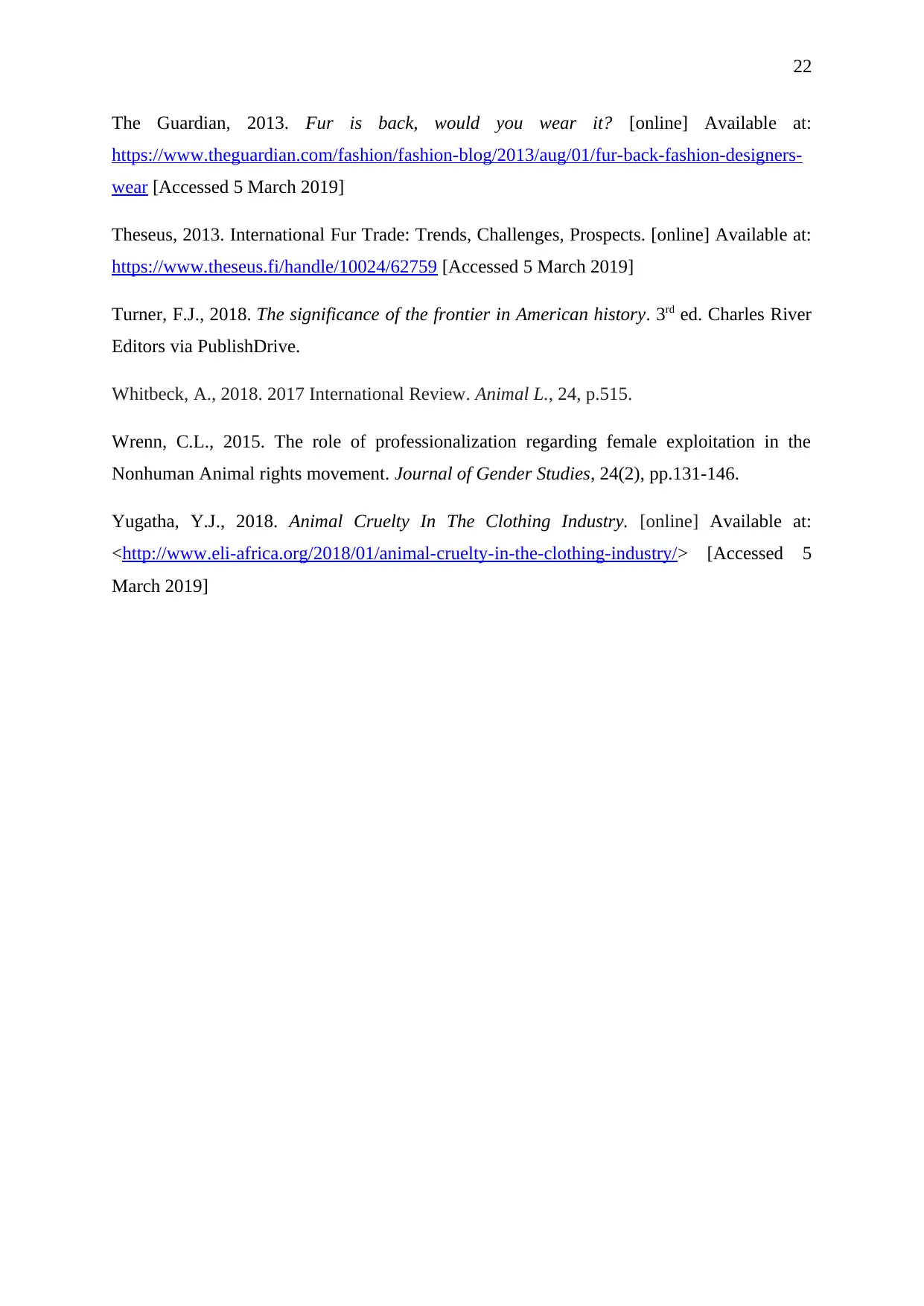
22
The Guardian, 2013. Fur is back, would you wear it? [online] Available at:
https://www.theguardian.com/fashion/fashion-blog/2013/aug/01/fur-back-fashion-designers-
wear [Accessed 5 March 2019]
Theseus, 2013. International Fur Trade: Trends, Challenges, Prospects. [online] Available at:
https://www.theseus.fi/handle/10024/62759 [Accessed 5 March 2019]
Turner, F.J., 2018. The significance of the frontier in American history. 3rd ed. Charles River
Editors via PublishDrive.
Whitbeck, A., 2018. 2017 International Review. Animal L., 24, p.515.
Wrenn, C.L., 2015. The role of professionalization regarding female exploitation in the
Nonhuman Animal rights movement. Journal of Gender Studies, 24(2), pp.131-146.
Yugatha, Y.J., 2018. Animal Cruelty In The Clothing Industry. [online] Available at:
<http://www.eli-africa.org/2018/01/animal-cruelty-in-the-clothing-industry/> [Accessed 5
March 2019]
The Guardian, 2013. Fur is back, would you wear it? [online] Available at:
https://www.theguardian.com/fashion/fashion-blog/2013/aug/01/fur-back-fashion-designers-
wear [Accessed 5 March 2019]
Theseus, 2013. International Fur Trade: Trends, Challenges, Prospects. [online] Available at:
https://www.theseus.fi/handle/10024/62759 [Accessed 5 March 2019]
Turner, F.J., 2018. The significance of the frontier in American history. 3rd ed. Charles River
Editors via PublishDrive.
Whitbeck, A., 2018. 2017 International Review. Animal L., 24, p.515.
Wrenn, C.L., 2015. The role of professionalization regarding female exploitation in the
Nonhuman Animal rights movement. Journal of Gender Studies, 24(2), pp.131-146.
Yugatha, Y.J., 2018. Animal Cruelty In The Clothing Industry. [online] Available at:
<http://www.eli-africa.org/2018/01/animal-cruelty-in-the-clothing-industry/> [Accessed 5
March 2019]
1 out of 22
Related Documents
Your All-in-One AI-Powered Toolkit for Academic Success.
+13062052269
info@desklib.com
Available 24*7 on WhatsApp / Email
![[object Object]](/_next/static/media/star-bottom.7253800d.svg)
Unlock your academic potential
© 2024 | Zucol Services PVT LTD | All rights reserved.



